Last Updated on July 11, 2023 by Carne Diem
Protein: 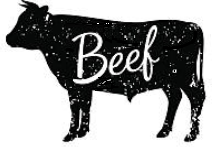
Origin: American, American South
Method: Smoker
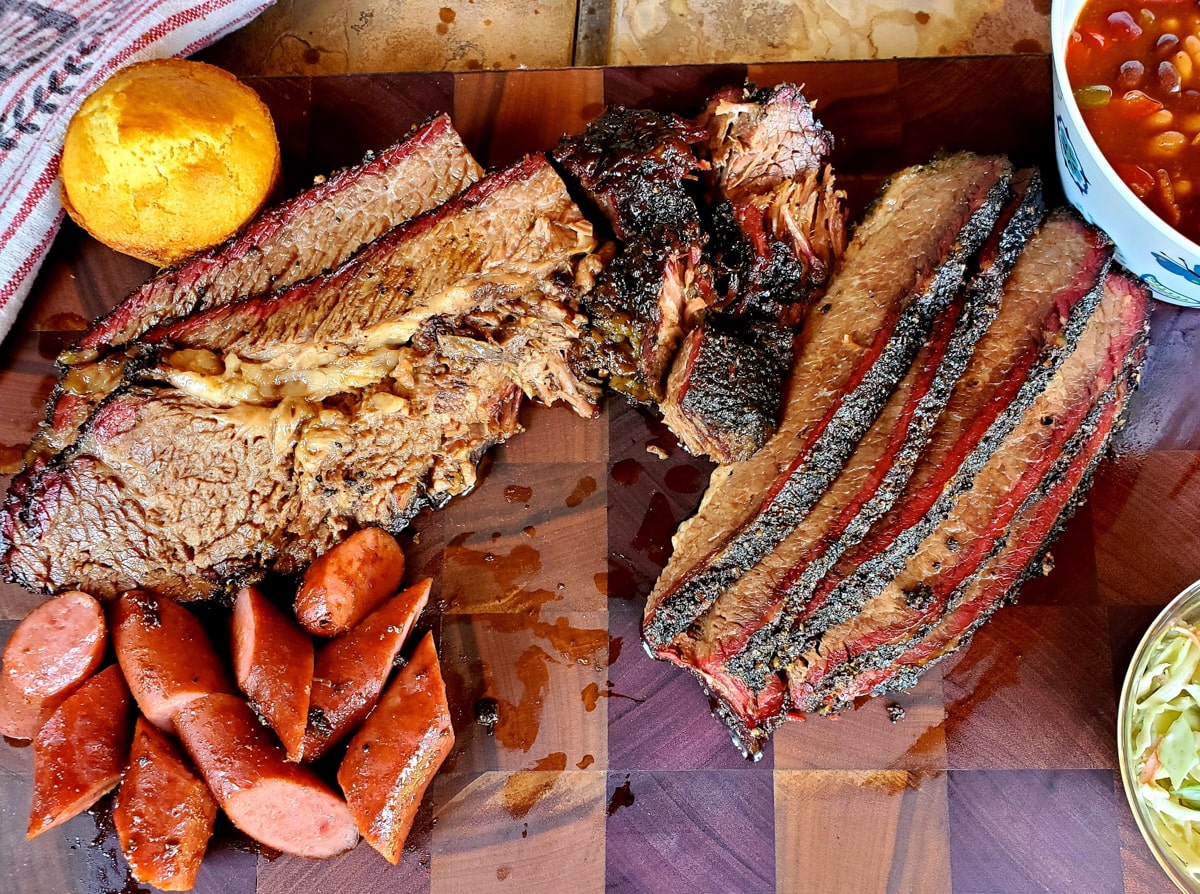
I probably see more questions on the BBQ forums regarding how to cook brisket, that any other protein. Brisket certainly can be a tricky cut of meat to cook correctly. It can be overwhelming to prep and cook the first couple times you do it. Once you learn the technique, however, it is a very rewarding cut of beef to cook, and one of our absolute favorites.
There seems to be a lot of "bad" information out there on how to properly cook a brisket. Most of the advice comes from people that mean well. They have found a system that works great for them (using their specific rub, on their specific smoker, and their specific technique). Brisket, however, is a finicky beast. What may work perfectly for one person, rarely translates perfectly to someone else that is cooking under different conditions.
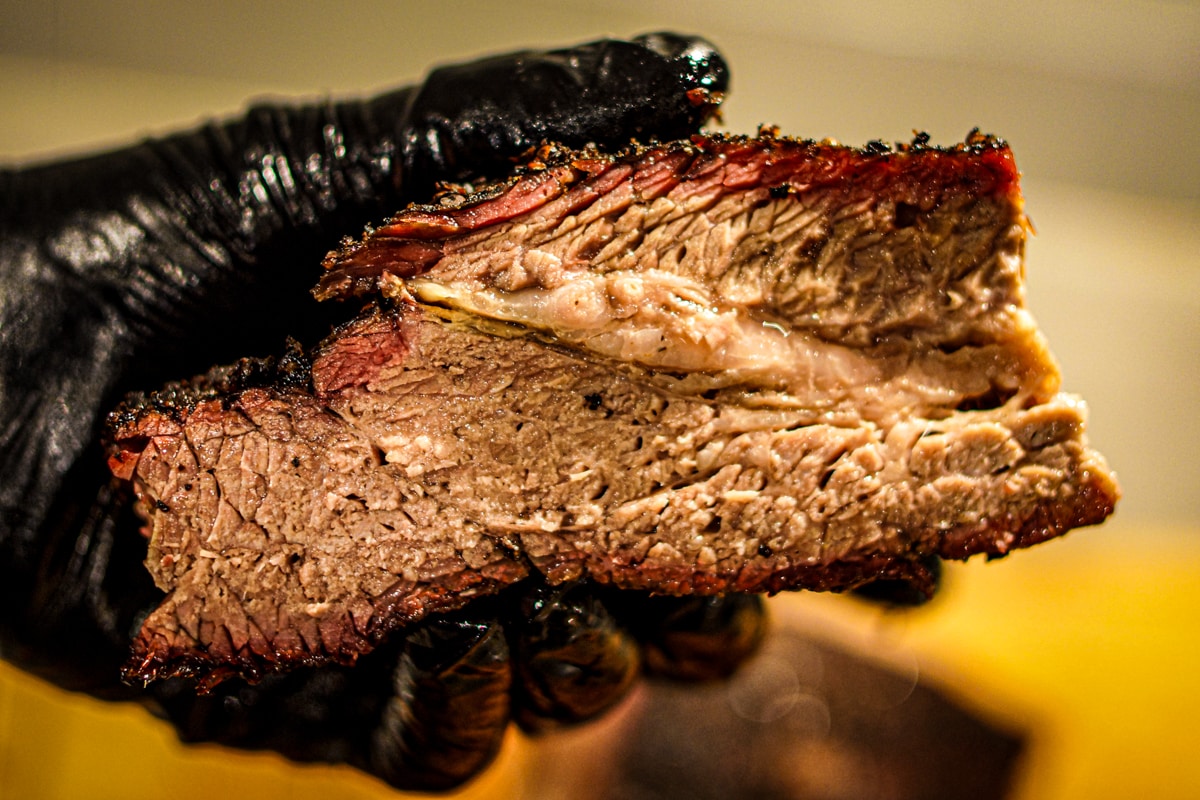
There is very much an art to good brisket, and it is 100% about learning how to read the cues the meat is giving us during a cook. It takes a lot of practice. There is a reason pitmasters like Aaron Franklin can basically spell out their entire process to the world and not really worry about a million weekend warriors replicating his finished product right out of the box. Here I hope to put together a step-by-step guide to Texas Style brisket. I will answer some of the most frequently asked questions and go over solutions to problems that I have come across over the years.
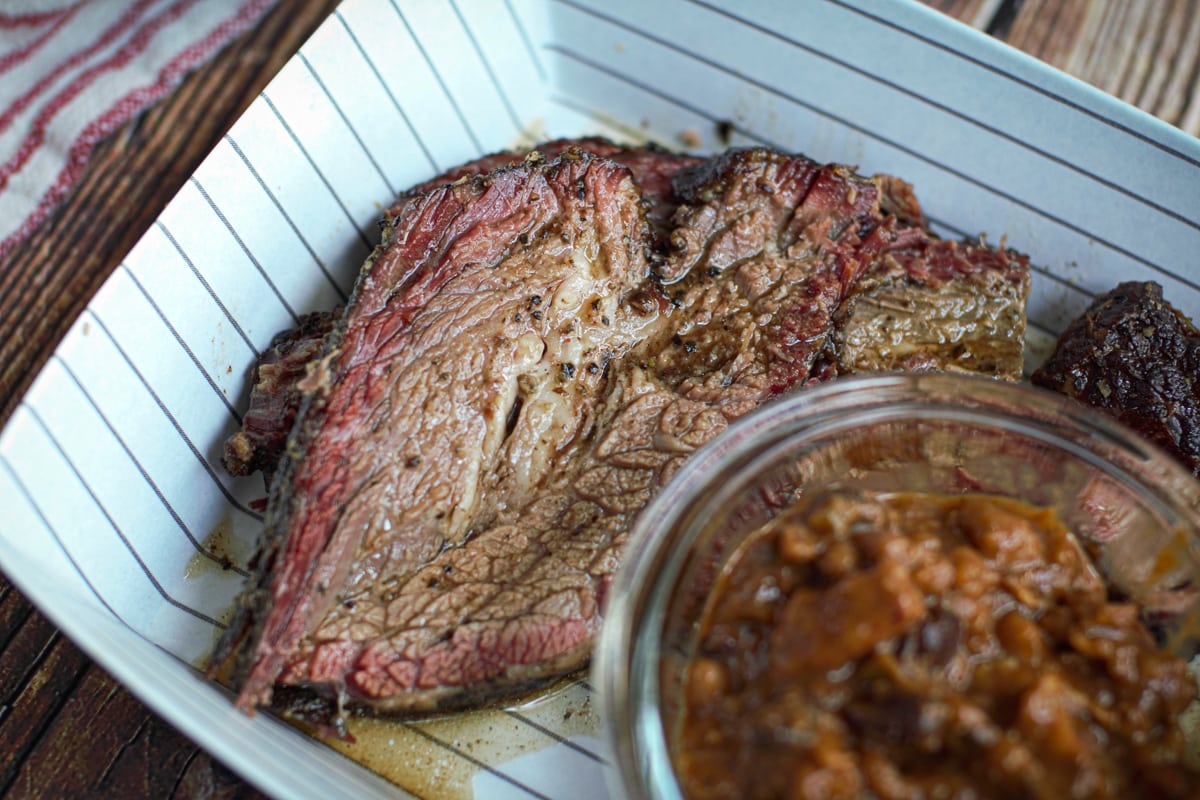
Table of contents
- What is Texas Style Brisket and how does it differ from Competition style brisket?
- Brisket: Packer vs Flat vs Point
- Sorting through the different grades of beef brisket
- What to look for at the store when selecting a brisket.
- Aging and Prepping a Texas Style Smoked Brisket
- Smoking Texas Style Smoked Brisket
- What Smoker is Best for Smoking a Brisket
- Do I smoke a brisket with the fat cap up or down?
- How do I know when my brisket is done?
- When do you wrap a brisket?
- How long should I/can I rest a brisket?
- Warm holding a brisket
- How to slice and serve a Texas Style Smoked Brisket
- What to Serve with Texas Style Smoked Brisket
- Other frequently asked questions when cooking a brisket
- Addressing Common BBQ Myths
What is brisket?
Brisket is a large cut of beef consisting of the pectoral muscles of the cow. Essentially it is the breast or lower chest section of the cow and is one of the nine beef primal cuts. Typically weighing 10-16 pounds, these frequently used muscles that make up a brisket are full of connective tissue and need to be broken down with a prolonged cook in order to make the meat tender.
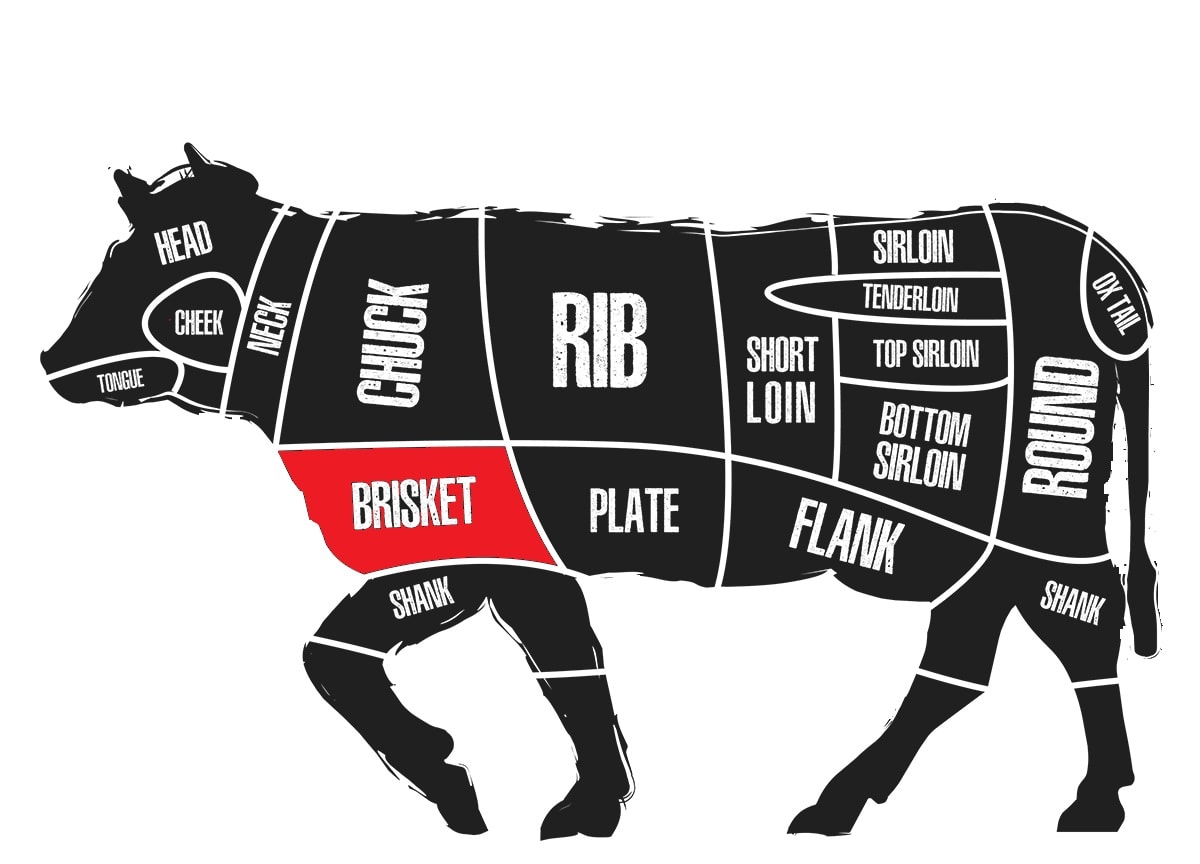
What is Texas Style Brisket and how does it differ from Competition style brisket?
When compared to a competition style brisket, Texas Style brisket is very minimalistic. Texas Style brisket is minimally trimmed, and simply seasoned. The finished brisket is then cut into "lean" and "moist" slices from the flat and point, respectively.
Competition brisket is a completely different animal, and we will discuss it in a future post.
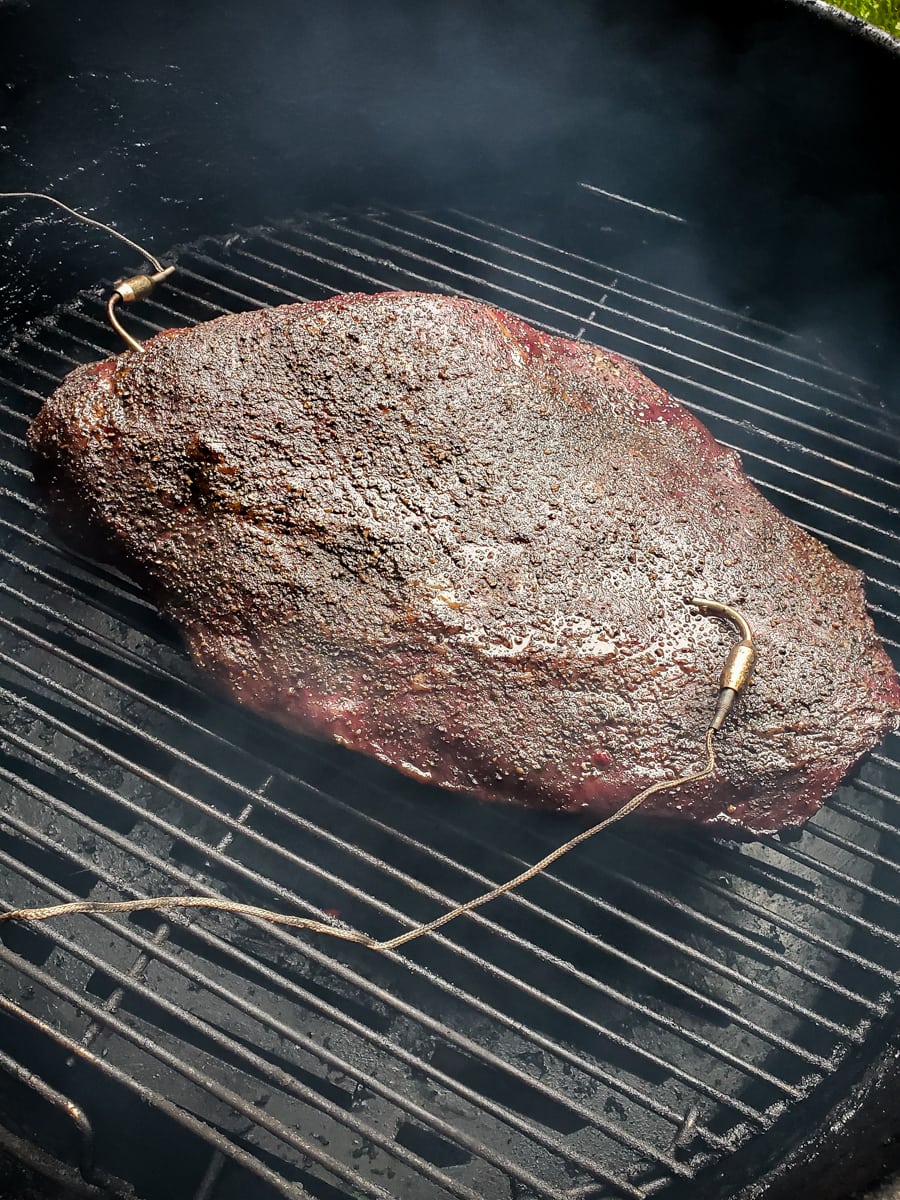
The Art of Texas Style Brisket: Step by Step Instructions
The recipe and techniques below are for producing a great Texas style brisket that you will be proud to serve to your family and friends. It sometimes takes years to learn how to do "the perfect brisket" so don't expect your first few briskets to rival Franklin's and cast a cautious eye toward anyone's recipes or techniques that claim it will. This technique will, however, give you the tools to make a really good brisket right out of the gate. It will also give you methods to correct things you didn't think were perfect, on future cooks.
We will try to address common pitfalls and give you a number of techniques to address any issues that you may have. We will also cover the most common questions that we see such as "fat cap up or down" and "foil vs butcher paper vs no wrap." As you will learn there are a million ways to cook a good brisket, you just need to learn to read the meat to know when to proceed to the next step.
The key to cooking a great brisket
If you learn only one thing about cooking a Texas Style Brisket, you need to learn how to judge tenderness and determine when the brisket is perfectly cooked. While this is one of the last steps in making a brisket, we are talking about it first because it is the most important. Everything that comes before and after, checking the tenderness can vary, or be altered. If the meat is not tender, however, you will likely not be happy with your results. You want to be sure that the meat is tender and that all of the fat and collagen is broken down and rendered.

Those that follow my blog have often heard me say to cook to temp, not a set time. With brisket, you have to take it a step further. You want to cook to tenderness, not a set temp, and certainly never just a set amount of time. Learning what the perfect tenderness is to pull a brisket is the biggest part of the art of a good brisket.
"This ain't Betty Crocker. For good BBQ cook to tenderness, not a set time and temp."
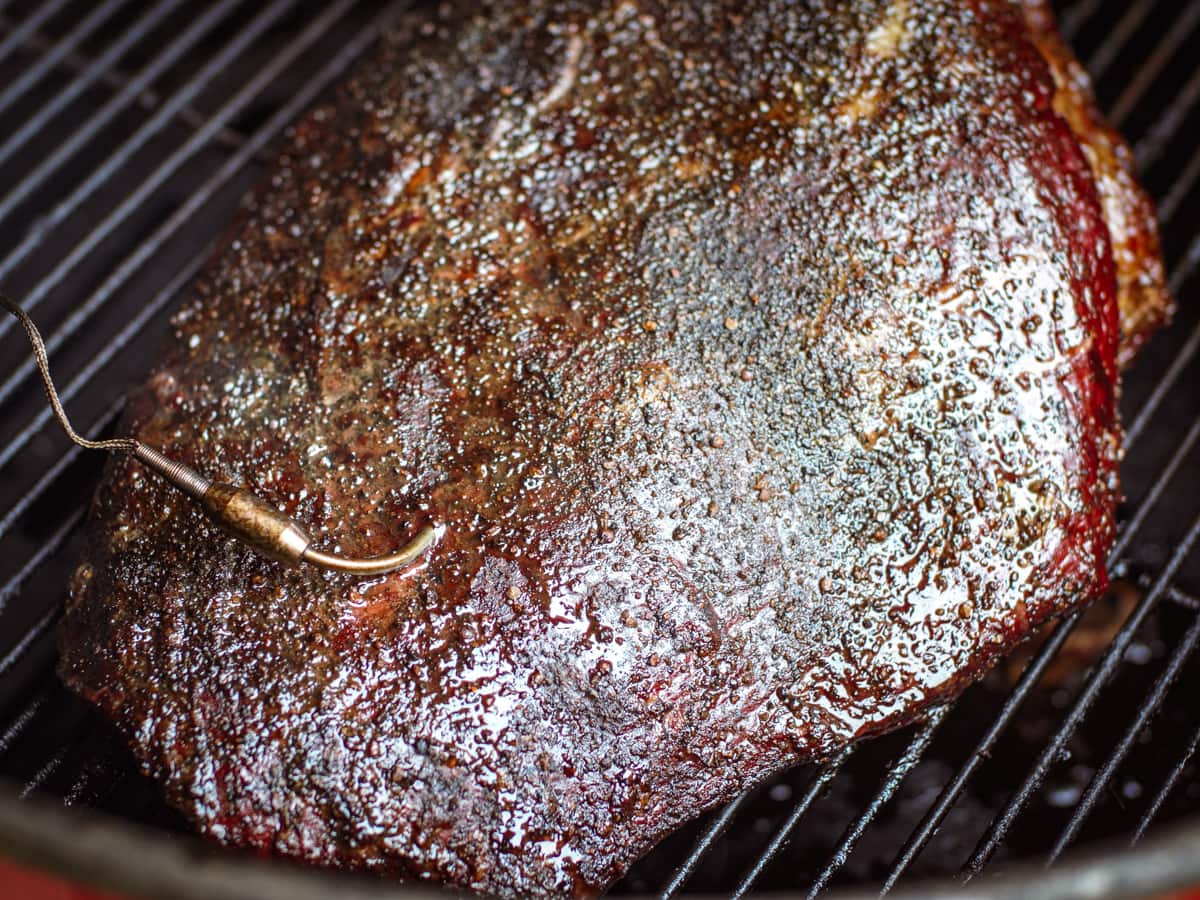
How to Select the Best Brisket
Brisket: Packer vs Flat vs Point
The first step in cooking a great brisket, is selecting the best piece of meat that you can find. When searching for brisket you may come across 3 different options. The first is a packer brisket. This is the entire brisket, and this is what you want to buy for Texas Style Smoked Brisket. The next 2 cuts you may see are the brisket point, and the brisket flat. These 2 sections of brisket are what make a whole packer brisket.
The flat end of the brisket is the flatter section (duh) and is the leaner section of brisket. You may also see the flat referred to as "the first cut". The point is the fattier section of brisket. The 2 sections of brisket are separated by a large vein of fat. You may also see the point incorrectly labelled as "deckle", however, this is not the proper name. The deckle is the hard fat that separates the brisket from the ribcage.
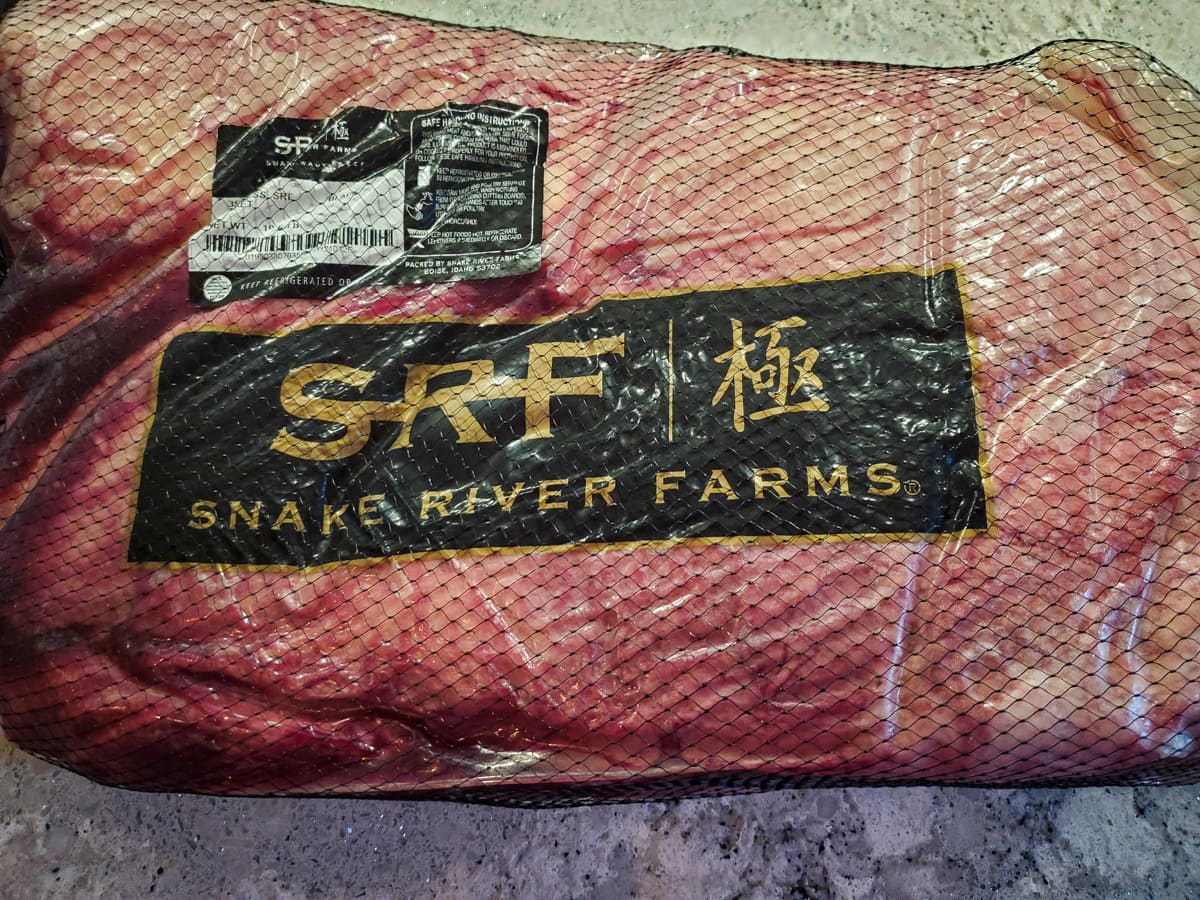
I recommend always getting a packer brisket. Yes, it is a lot of meat and can look intimidating, but ultimately it is going to cook better, and if you compare the prices, it is not that much more that the trimmed flat sitting in the display next to it, that is lower quality and half the weight. Buying a flat only you are basically paying double the price per pound to have the butcher remove some of the best part of the brisket and save you 5-10 minutes of trimming. For true Texas Style Smoked Brisket, you always want to cook a whole packer.
Sorting through the different grades of beef brisket
In the U.S. beef is classified into a number of grades ranging from Prime all the way down to cutter or canner grades, which are seldom seen at retail. The top three grades: prime, choice, and select, are what we will focus on for making a great smoked brisket. Prime brisket is going to be the most well marbled and tender of the graded brisket in the U.S. Prime meat represents about the top 5% of beef sold in America. This is what we typically cook. Select beef lacks the marbling of Choice and Prime beef and thus is typically considered to be more lacking in flavor and tenderness compared to the higher graded cuts.
I recommend always cooking at least a Choice brisket. Avoid select unless that is all you can find. If you have a Costco or Sam's membership, I would recommend getting the prime briskets, they typically are about the same price you are going to pay for choice in a regular store.
What about wagyu brisket?
Wagyu brisket is awesome and worth the occasional splurge, but I would not recommend using it until you have really mastered your cooking technique. Messing up a $200 piece of meat is a hard pill to swallow. In addition, despite what some may think, cooking a more expensive cut of meat with a bad technique is not going to automatically result in good BBQ. While wagyu is popular on the competition circuit, there is really no need to spend that much on a brisket to be cooked at home. You can turn out a great Texas style brisket with choice or prime. In fact, the entire reason brisket become so popular in Texas is because they became the masters of turning a tough cheap cut of meat into something mouthwatering and spectacular.
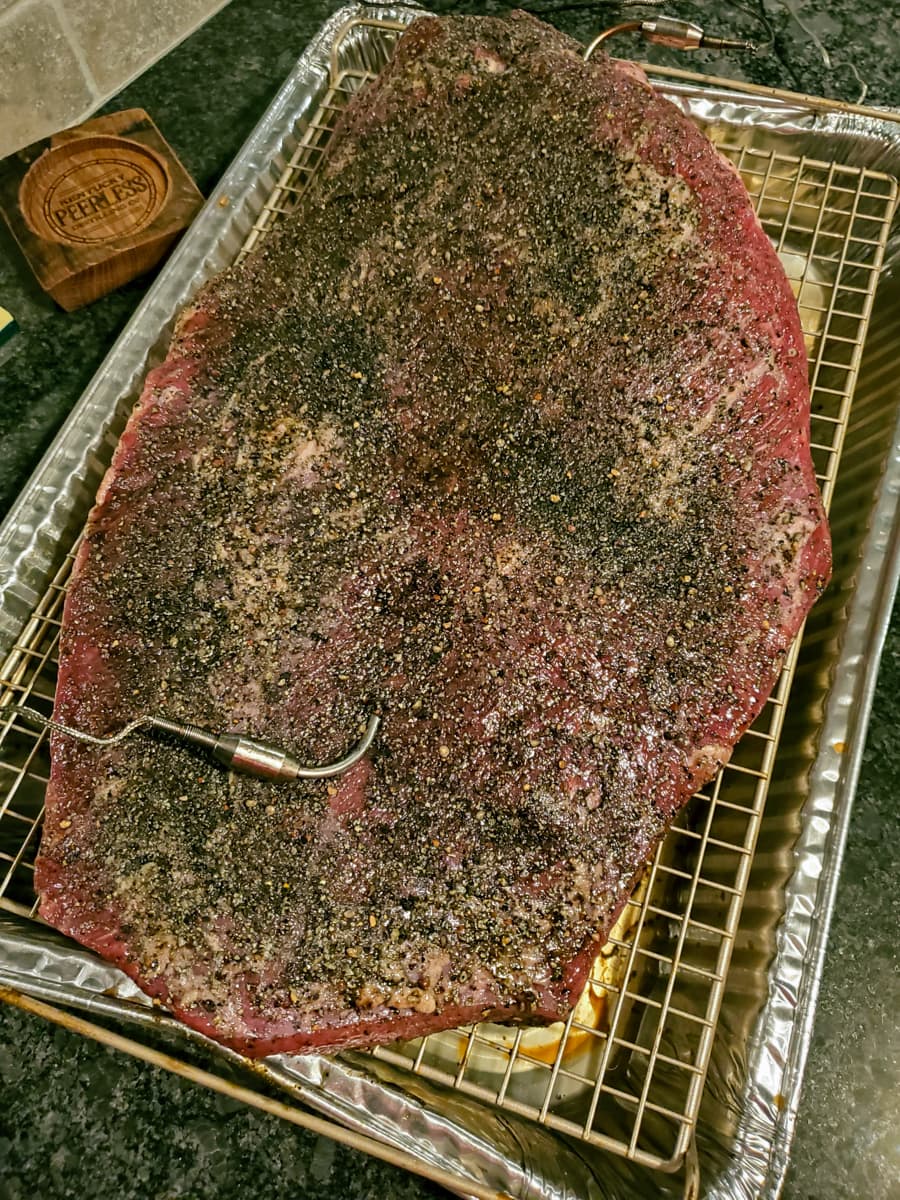
What to look for at the store when selecting a brisket.
Always buy brisket that is in Cryovac packaging if possible. This enables you to wet age the brisket for added flavor and tenderness. Look for a brisket that has a nice thick flat. Preferably the flat will be at least an inch thick and will remain uniform all the way to the edges of the brisket. You want to see good marbling with thin fat streaks running through the meat.
Next, pick up the brisket and give it a shake. You want to brisket to be a little floppy. If it is ridged as a board, it likely has a lot of hard fat that is not going to render well. Avoid briskets that look like they have been over trimmed, where too much fat cap has been removed, or where there are visual signs of gashes in the meat from an overzealous butcher.
Aging and Prepping a Texas Style Smoked Brisket
How do you age a brisket?
As mentioned, for best results you really want to get a brisket that is in cryovac. This allows you to wet age the brisket for a few weeks. Make sure the cryovac packaging is sealed properly and free of any leaks or large air bubbles. Put the brisket in the fridge and leave it there for a few weeks. Place the brisket in the back of a refrigerator where it will not be disturbed and preferably in one that is not opened and closed frequently.
How long is brisket good past the sell by date?
Trust me, as long as the brisket is in a properly sealed cryovac it is fine well past the sell by date. I have cooked great briskets that were a couple months out past sell by and they turn out great. This wet aging process helps the brisket become more tender and adds a bit more "beefy" flavor to the brisket. Starting out, try wet aging the brisket for a few weeks. If the brisket is not in the original cryovac, however, you do not want to wait to cook it much past the sell by date. With any meat, when in doubt toss it out. If a brisket does not pass the smell test, don't risk it.
How do you trim a Texas Style Brisket?
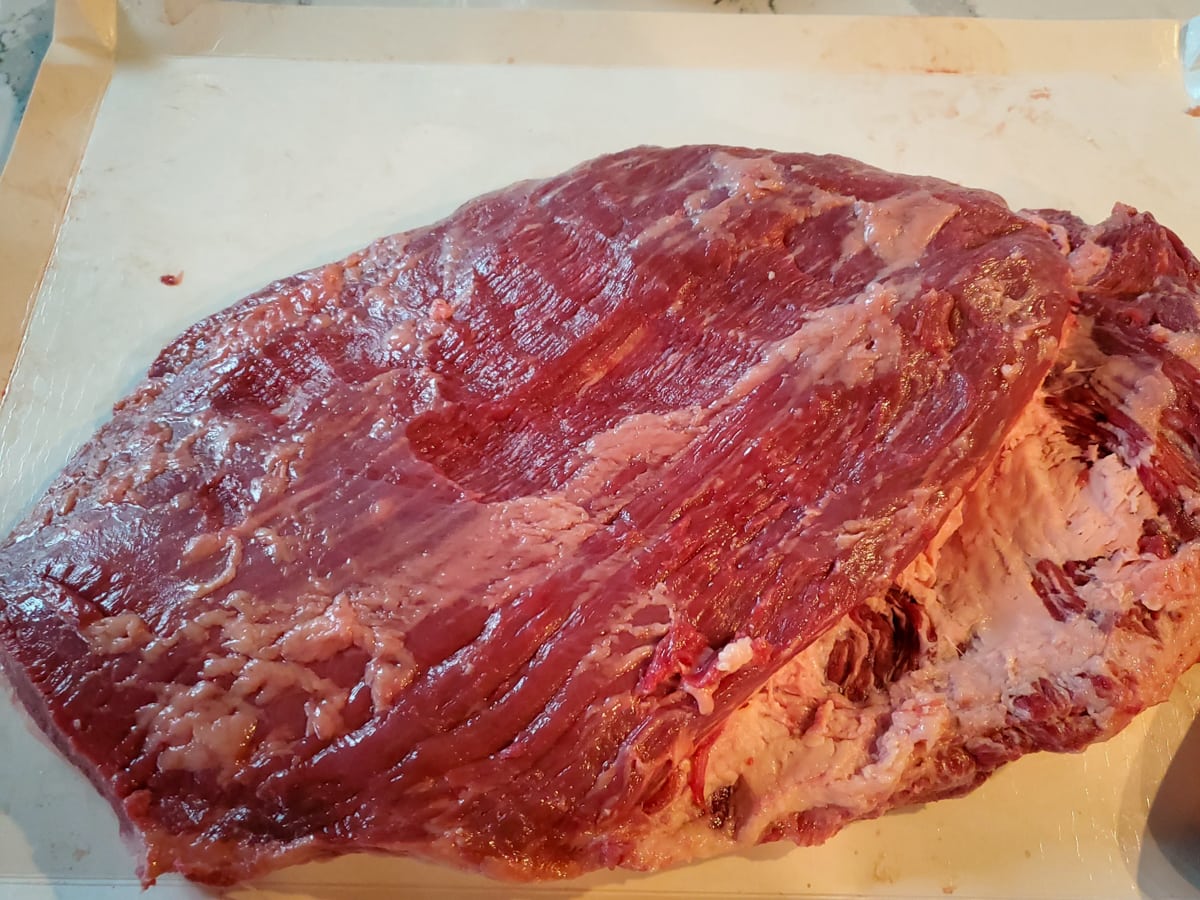
The best thing about Texas Style Smoked Brisket is that, compared to competition style brisket, it requires very little trimming. While some people swear by not trimming a Texas style brisket at all, we find a small amount of trimming is best.
To trim the packer brisket, remove the hard kernel of fat from the brisket. Next, trim any gray or discolored meat of fat from the brisket, including a thin slice along the edges of the brisket. Finally, you may choose to take a small amount of fat from the fat cap, but this is not necessary and don't overdo it. We typically just remove any slimy, or discolored fat.
We also typically trim any thin or loose pieces of meat to help have an even cook throughout the brisket. If you have a meat grinder, these brisket trimmings are perfect for brisket burgers.
Brisket Trimming Tip: If you are new to brisket, you may find it helpful to take a small cut against the grain of the brisket at the end of the flat, so you know which way to cut after the brisket is cooked.
Should I inject my brisket?
When it comes to injecting this is all about personal preference. Do you need to inject? Absolutely not, you can make a fantastic brisket without injecting it. Can you tell the difference? Yes, there is a reason competition teams inject their brisket. There is a noticeable difference in the flavor of the brisket and in some case with moisture retention. My family can typically tell when I have not injected my brisket. Still, for the home cook, there is not really a need to go out and spend a lot of money on professional brisket injections loaded with phosphates. A simple injection of some beef broth will typically do the
trick.
Traditionally, Texas style smoked brisket is not injected, but for those that insist on doing it the way the competition teams do, Kosmos brisket injection and Kosmos Reserve brisket injection are our go to injection when we compete. That said, again this article is about Texas Style BBQ Brisket so injection is not necessary or common place.
What type of seasoning is used for Texas Style Smoked Brisket?
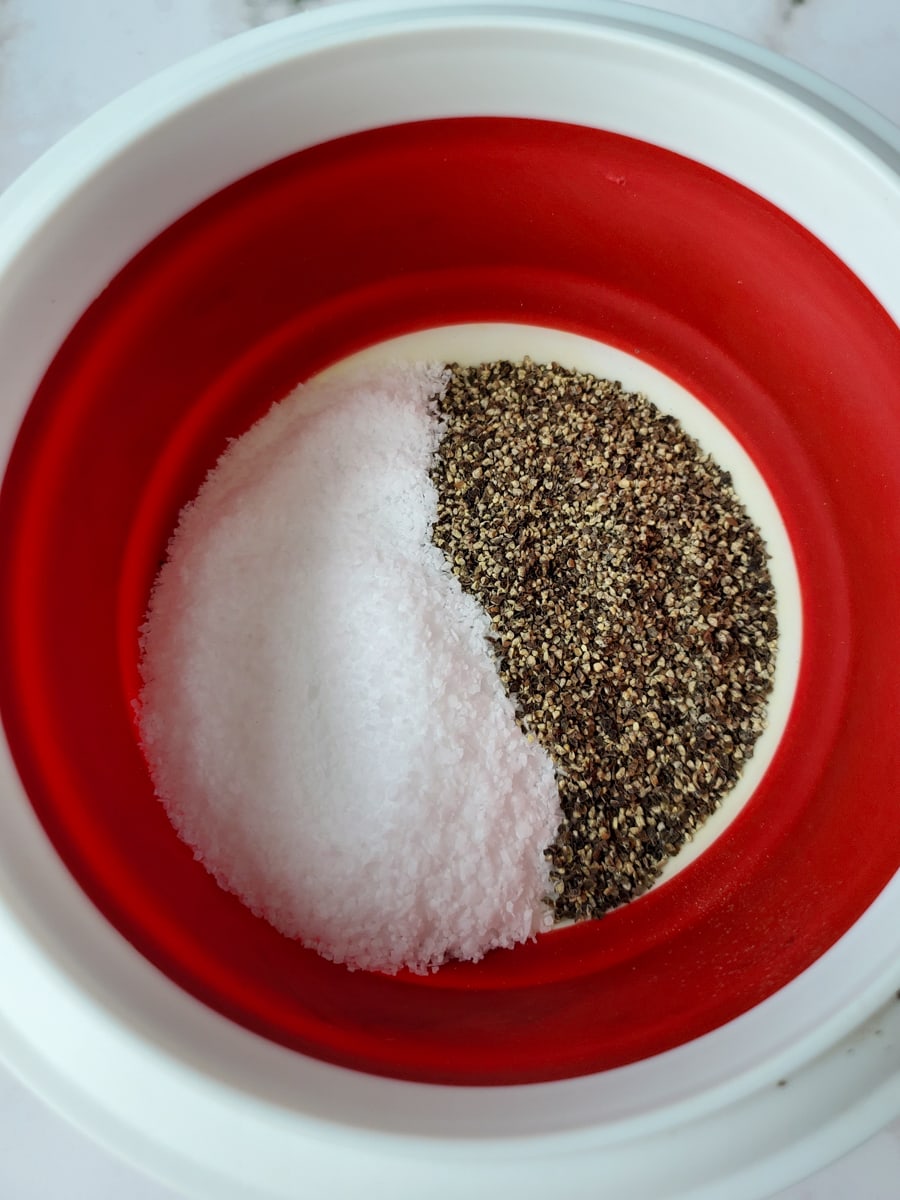
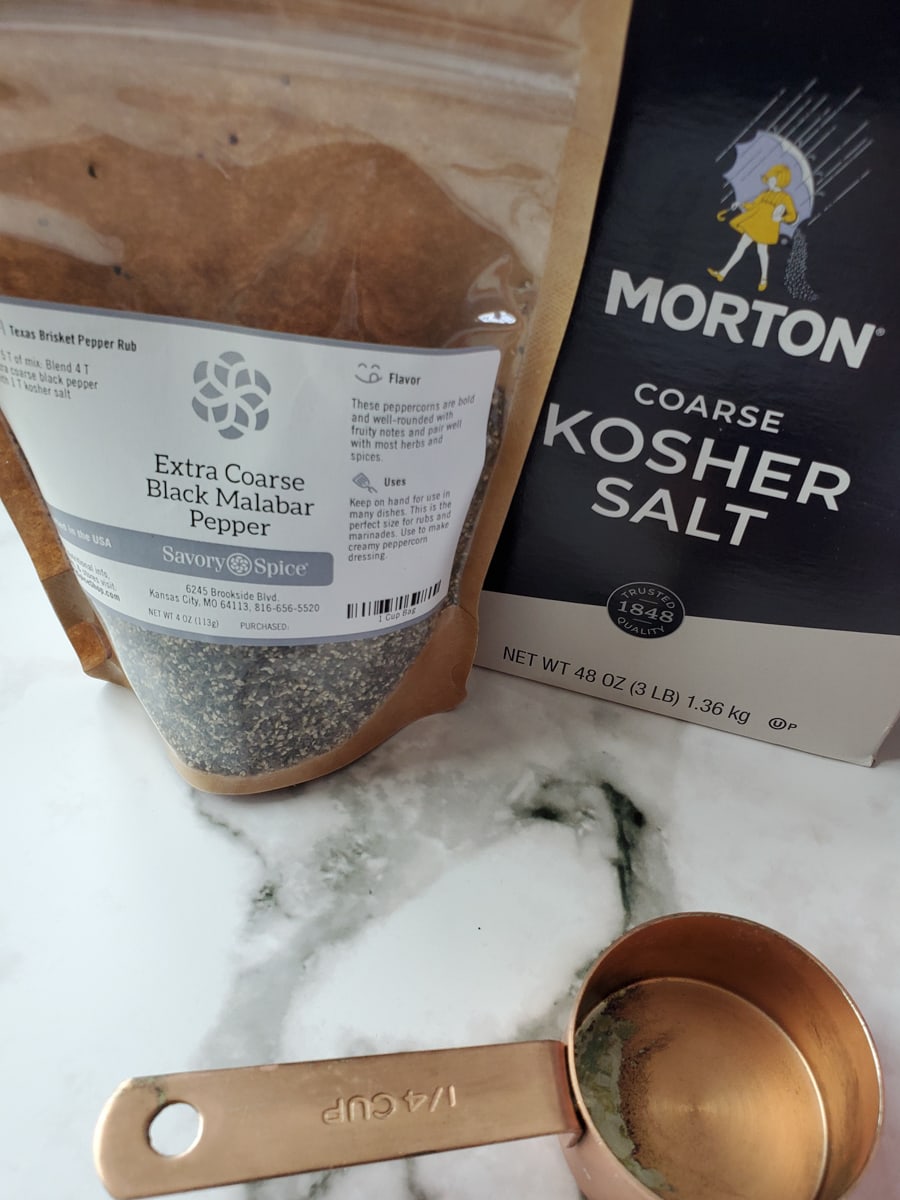

If you ask most Texans how to season a Texas Style brisket, almost all will respond with something along the lines of "Only salt and pepper." Traditionally a 50:50 blend or coarse salt and coarse ground pepper (10-20 mesh) is used. Lately it seems there has been a little more wiggle room as to what is acceptable, with some pitmasters adding in a little paprika, garlic powder, or chili powder. Ultimately it is your brisket so use a flavor profile that you like, but salt and pepper should make up the bulk of the seasoning and avoid using too much (if any) sugar in your rub.
Additions, like smoked pepper, activated charcoal, and smoked salt can also be used to help with the flavor and color of your brisket if desired.
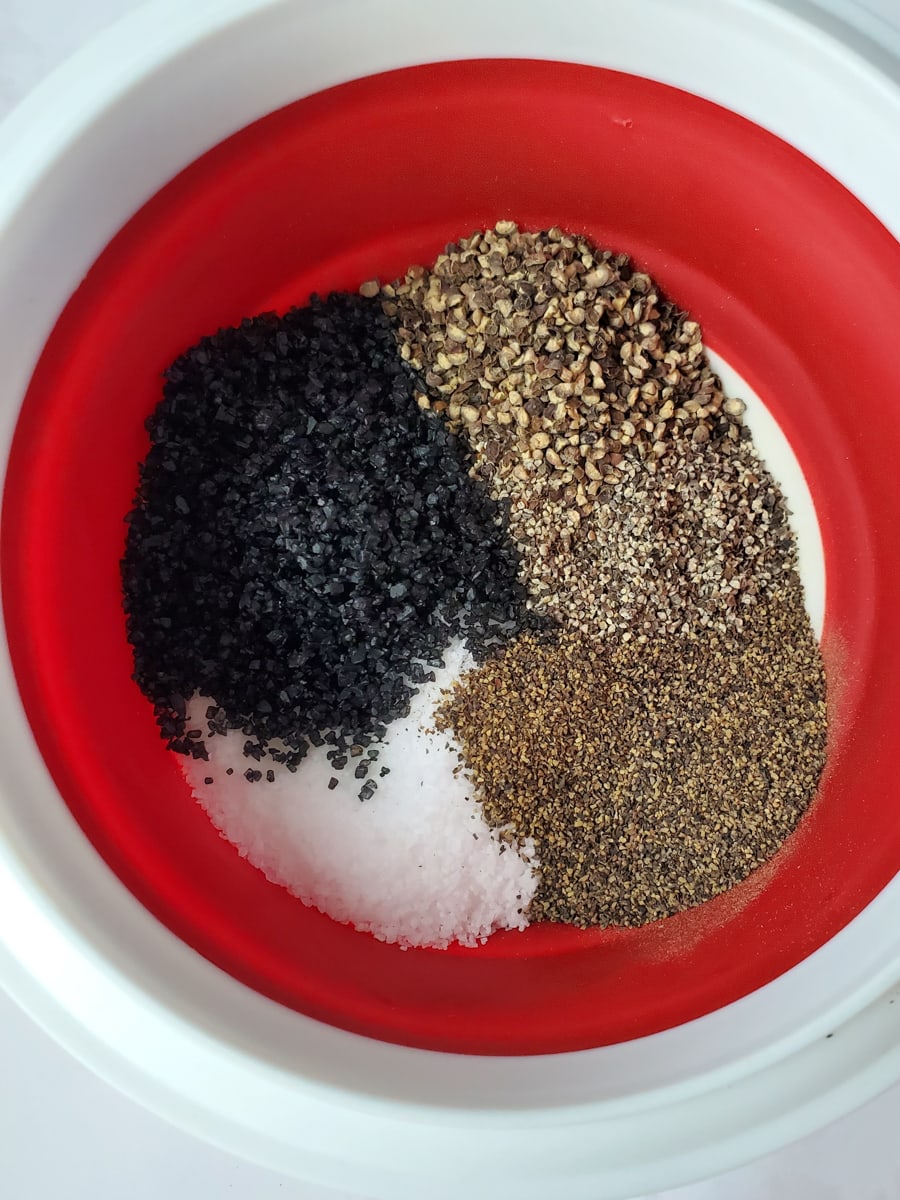
When do you apply rub to a brisket?
We find the best time to apply the rub is the night before. This allows the brisket time to "sweat" and allows time for the salt in your rub to penetrate the meat. As salt pulls some of the moisture to the surface of the meat, this also helps with smoke adherence for a more profound smoky flavor. After seasoning the brisket, wrap it up in plastic wrap until you are ready to cook, or place in a covered container. You can hit the brisket with a little additional brisket rub right before going on the smoker.
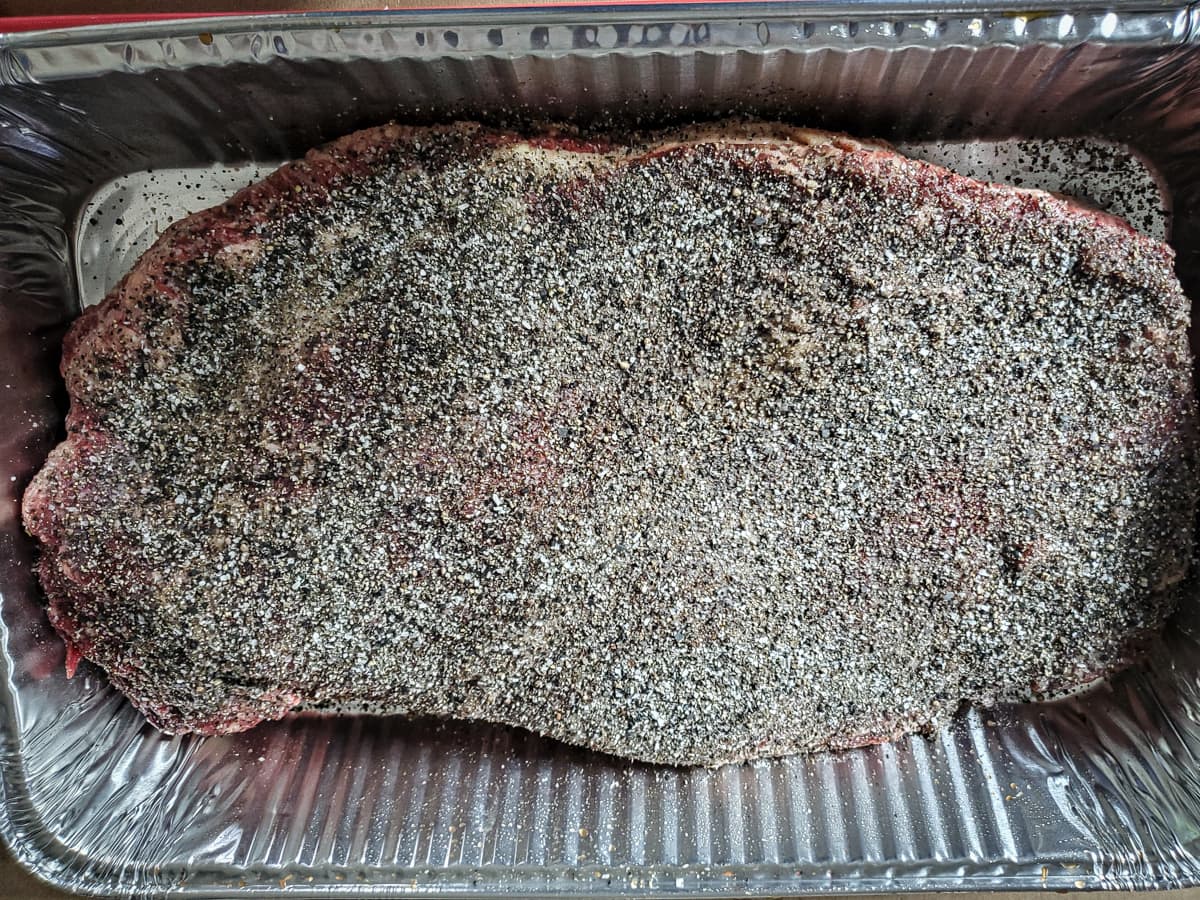
If you can't season your brisket until just before cooking, don't worry too much about it. It is not going to make or break your cook. Regardless, you want to be pretty liberal, with your seasoning. A brisket can take quite a bit of seasoning.
Smoking Texas Style Smoked Brisket
Now that your Texas Brisket is aged, trimmed, and seasoned it is time for it to hit the smoker.
What Smoker is Best for Smoking a Brisket
When it comes to smoking a brisket the best smoker to use is the one you are most comfortable with. You can make a great brisket on a pellet smoker, drum, offset, or pretty much any type of smoker. Some smokers do have minor differences in how it is best to cook the brisket, but once you learn your smoker you can use just about anything you want. I will mention variations in cooking techniques with different smokers as we get into the details of smoking a brisket.
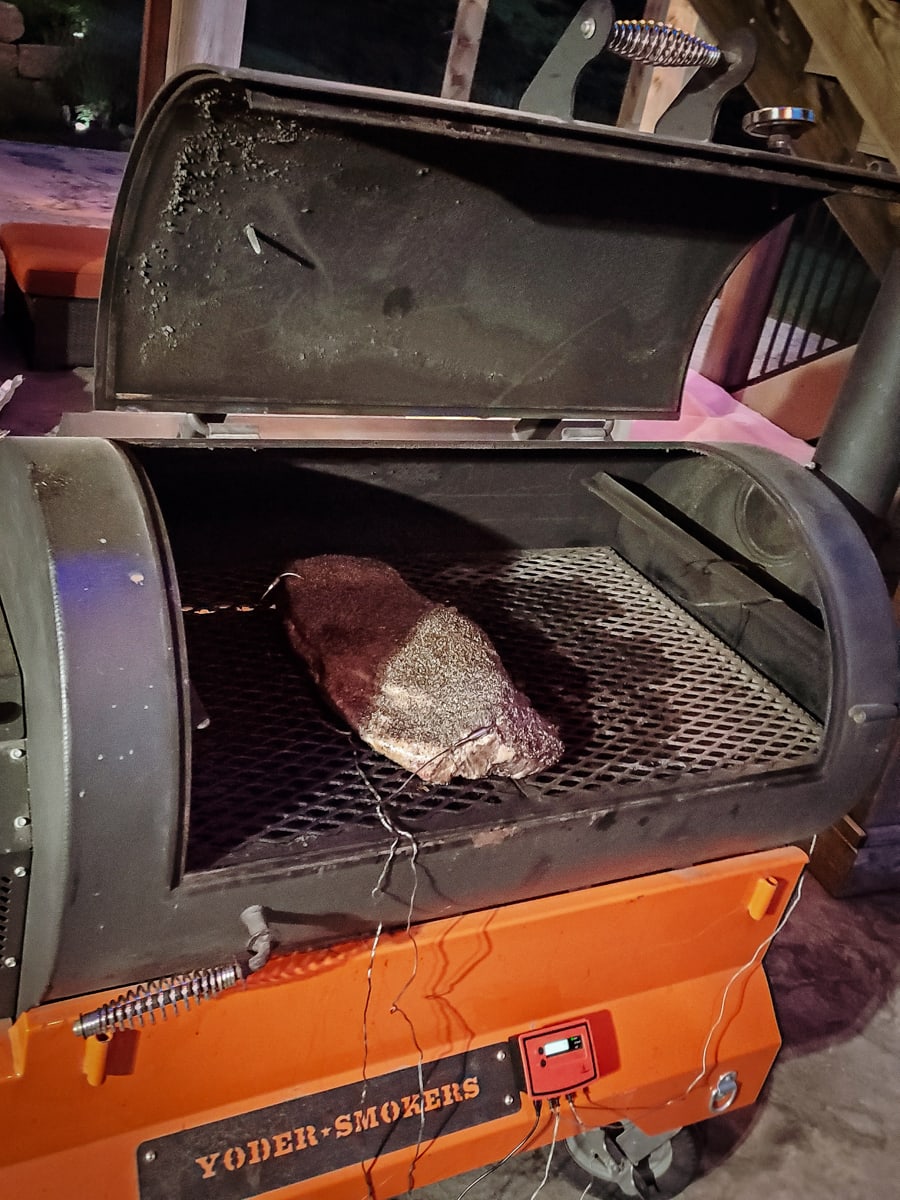
Should I put the brisket on the smoker warm or cold?
Not quite as popular of a question as fat cap up or down, is should I let the brisket set out at room temp before cooking. There was once a belief that by letting your brisket sit out at room temp for a couple hours it would in some way help it to cook more evenly and quickly. While there may be some truth to that statement with proteins like a steak (which is still debatable), there is no shown benefit to doing this with large cuts of meat and you may be risking doing more harm than good. Even after sitting hours at room temperature, the internal temperature of the brisket will change very little.
Risk of food borne illness aside, by letting your meat sit out at room temp, the outside of the meat does increase in temperature. This in turn does not really change the cook time much, but the fact that the outside of the meat is now warmer and drier does decrease the amount of smoke particles that adhere to the surface of the meat. In addition, for those of you that are still chasing a smoke ring, it will greatly decrease ring formation as the chemical reaction responsible for smoke ring formation only occurs at lower temperatures.
Do I smoke a brisket with the fat cap up or down?
This is the most hotly debated topic in BBQ. In short fat cap up vs down does not really matter, save for a few specific examples. Typically, you want your fat cap toward the heat source. So if you are cooking above a fire box on a pellet smoker, or on a drum or ceramic smoker, you want the fat down to protect the meat. If the heat is coming from above, you want the fat cap up. On other smokers where the heat is more evenly distributed, the orientation of the brisket does not really matter as much.
Tip: There is a myth that by putting the fat cap up, the fat with render down through the meat and keep in moist. This is a myth, the melted fat just runs down the outside of the brisket, taking some rub with it as it goes. For more details, Meathead at Amazing Ribs, goes into great detail about the science behind this.
Cook temp and its effects on your brisket
There are many camps out there as to what is the best temperature for smoking a brisket. Largely, the cook temp does not matter as much as people think. You can make a great brisket at 225 degrees, or at 300 degrees and anywhere in-between.

A lot of traditionalists will argue that a brisket has to be cooked low and slow at 225. In reality, this is not really the case and many are realizing that you can cook briskets at a higher temp like 275 or 300 and still get fantastic results. In fact, even World renowned pitmasters like Myron Mixon and Aaron Franklin, are known to cook their briskets at temperatures outside of the traditional low and slow.
Why cook brisket low and slow?
- Cooking a brisket low and slow gives you more control over the cook. The brisket will spend more time in the window of "perfectly cooked" before it becomes overcooked. This is beneficial for beginners that are still learning to judge tenderness.
- The longer cook time can allow more time for smoke flavor and smoke ring development. Because the brisket spends longer on the smoker, you can develop more smoke flavor. Conversely, you can over smoke a brisket if left in the smoke for too long.
- The timing works out better for you. Honestly this is one of the reasons low and slow likely originated as ranch hands, etc. would let meat slow cook while they went about their daily activities. When they returned in the evening the meat was done. Cooking low and slow overnight, may be a better option for those wanting to eat brisket at the lunch hour.
Why cook brisket hot and fast?
- A hot and fast brisket can give an equally delicious result in a fraction of the time. In addition, you save of wood and fuel costs as you do not require long cooking times.
- A hot and fast brisket, when cooked correctly, actually retains more internal moisture than a low and slow brisket. Complaints of hot and fast briskets, being dry are often due to people assuming the brisket is done at 200-203 and blindly removing it from the smoker. At this point the collagen has not fully broken down and the fat has not rendered so the brisket may seem dry, because it is undercooked. A hot and fast brisket requires a higher internal temp to be tender and moist, sometimes as high as 210. If you remove the brisket at probe tender, this is not an issue. The bark on a hot and fast brisket can cook more quickly, so it is recommended that you monitor the brisket and wrap once the bark is set or begin to spritz the brisket when you are happy with the bark.
- The timing works out better for you. If you don't want to tend to a fire overnight, you can easily get up in the morning and have a hot and fast brisket ready for dinner. This still allows time for a proper rest/hold as well.
If you follow the guidelines of wrapping when your bark is set, and pulling the meat off when it probes tender and not at a set temp, there is typically very little difference in low and slow cooked briskets and cooking hot and fast.
Smoker type and cook temp
While smokers like drum smokers, bullets, and ceramics will undoubtably turn out great hot and fast barbeque, offset smokers may have issues maintaining the higher temperatures. Pellet smokers may also benefit from low and slow, as they produce more smoke flavor at lower temperatures than higher temperatures.
How do I know when my brisket is done?
Often people want to know, what is the best temperature to remove the brisket from the smoker. In fact, there is not set temperature in which a brisket is always going to be perfectly cooked. That is why you will see so many different opinions. 203 is not some magic number and can result in an overcooked or undercooked brisket. For the perfectly cooked Texas Style Smoked Brisket you want to probe the brisket for tenderness. This is the only way to know for certain that your brisket to done. Meat quality, brisket size, elevation, smoker type, and cook temp all play a role in when a brisket is tender.
How do you probe a brisket for tenderness?
To probe the brisket, you want to use a temperature probe or even a wooden skewer to probe the packer brisket in the thickest part of the flat. Typically, the brisket will become probe tender between 198 and 208 degrees, so we typically start checking at an internal temperature of about 195. In a perfectly cooked Texas style smoked brisket, the probe should feel like it is sliding into a stick of warm butter, or jar of peanut butter. You want almost no resistance. If the brisket still feels tight, check about every 30 minutes until the brisket is tender.

How does cooking temp effect brisket tenderness?
Brisket tenderness is the result of time and temperature. In general, the lower the temperature that you cook at, the longer it has to break down collagen and render fat. As a result, your brisket will probe tender at a lower temperature (sometimes as low as 195 if cooked below 200, which we don't recommend).
Conversely, a hot and fast cooked brisket will typically need to be taken to a high internal temperature to become tender. Frequently our hot and fast briskets will need to be taken over 208 degrees before they are tender. This can cause a great deal of stress to those that think every brisket should be tender at 203 degrees. You just need to trust the process.
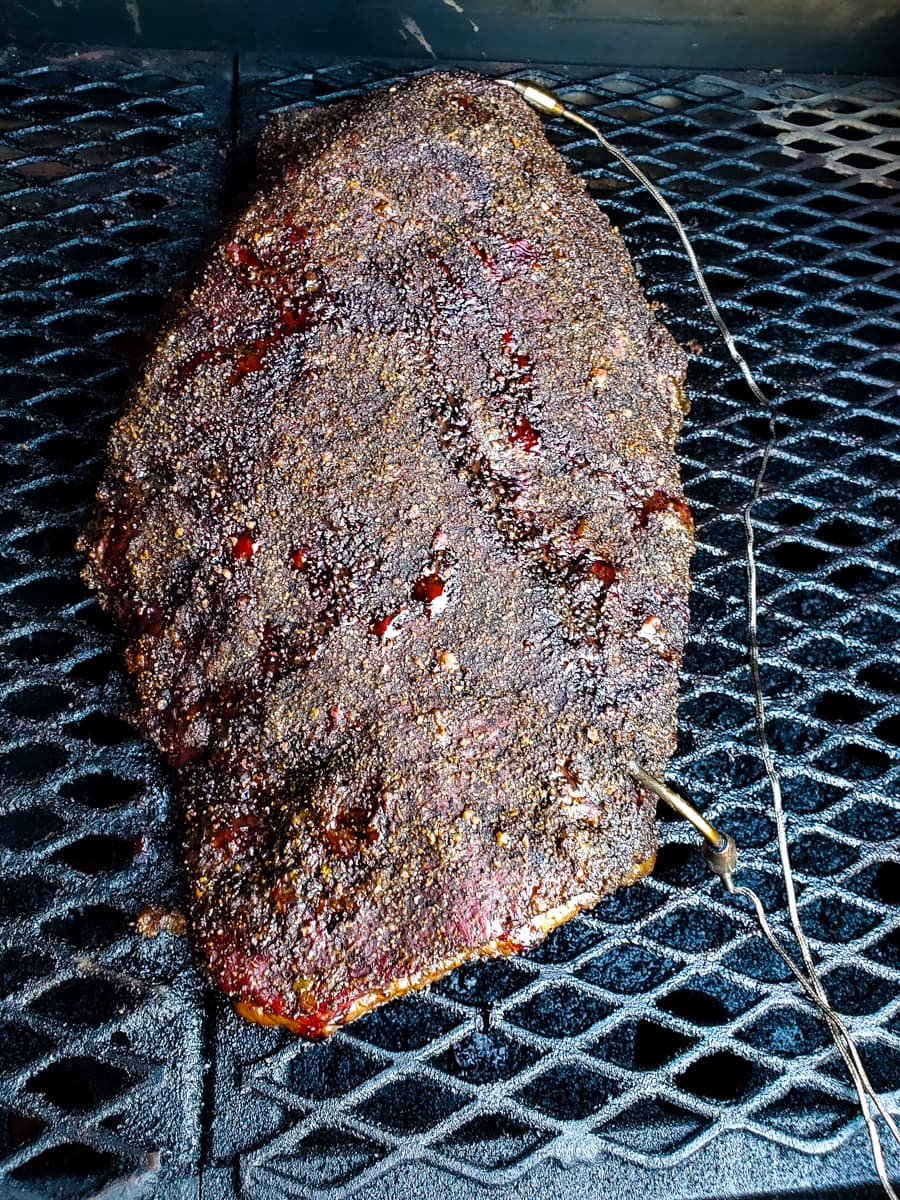
Should I wrap a brisket or not?
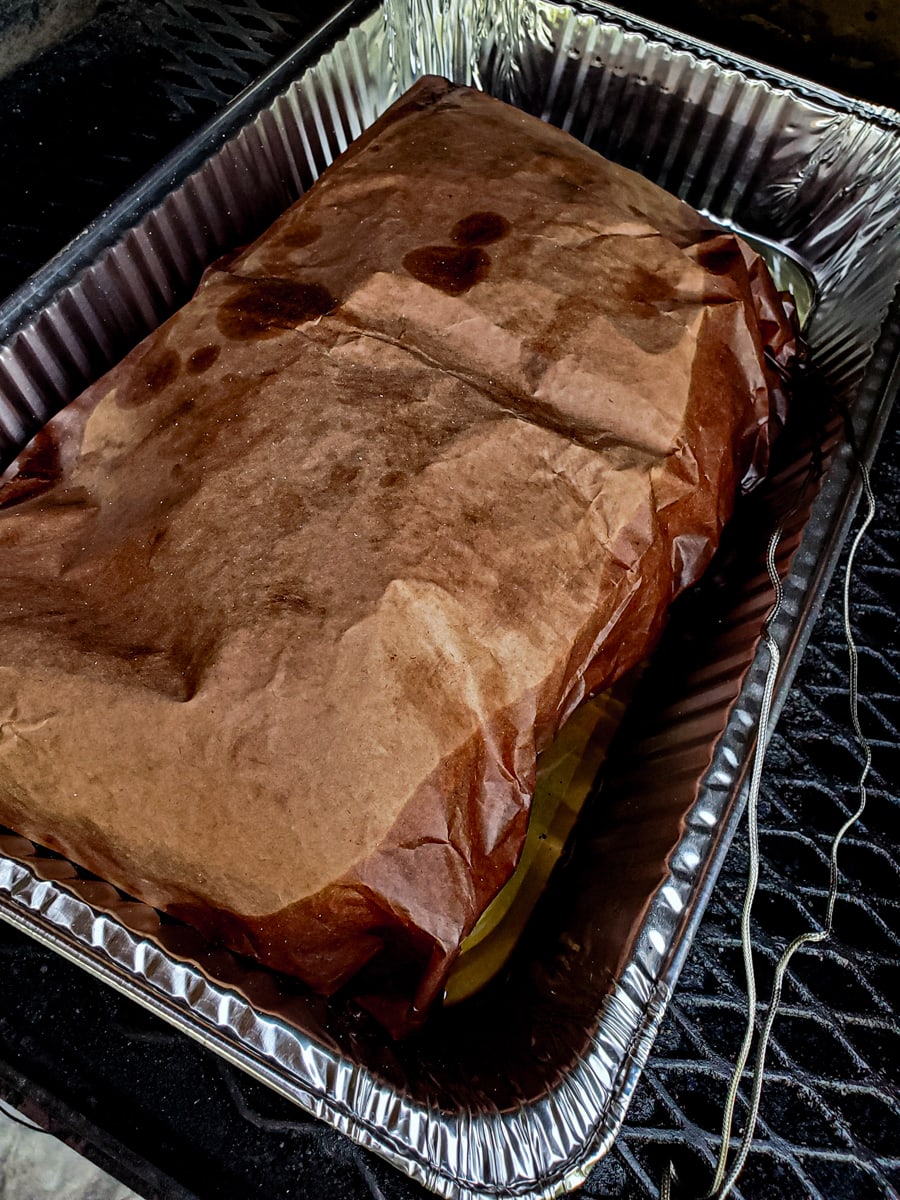
This question will cause almost as many arguments as fat cap up or down. Known as the Texas crutch, wrapping a brisket to push through the stall is a popular technique. In short you can make a great brisket by wrapping in either foil or pink butcher paper (both of which have their pros and cons), or leaving the brisket unwrapped. A lot of this comes down what you find to be most important in your final brisket result. If getting a great bark is your ultimate goal, you may want to try cooking the brisket unwrapped. If getting a moist juicy brisket is your ultimate goal then wrapping may be the best method for you, though at the sacrifice of some of that dark crusty bark.
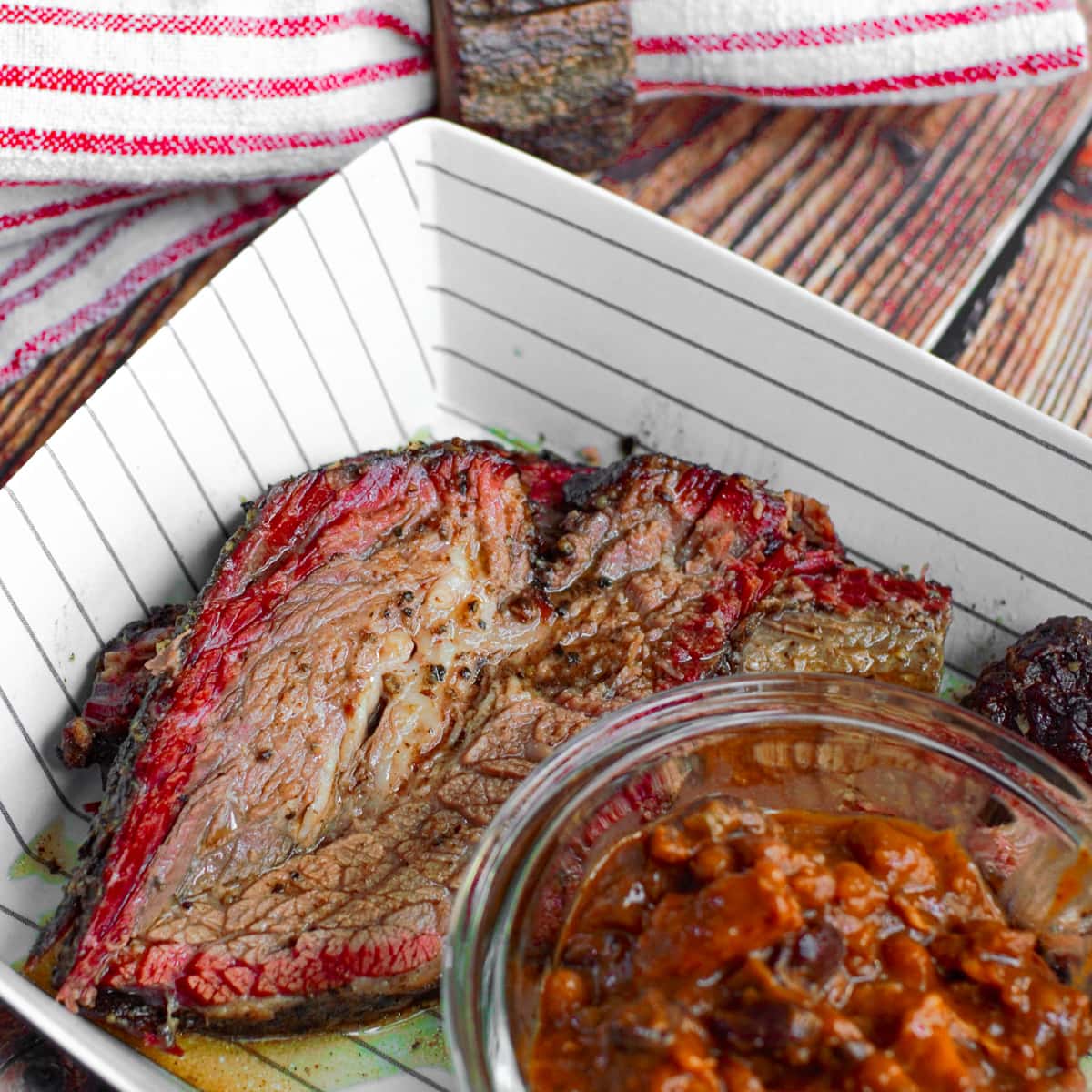
Summary of Brisket Wrapping Methods for smoked brisket
Unwrapped: This method will result in the best bark formation but may be prone to drying out on some smokers. If using this method, you may consider spritzing the outside of the brisket with a mixture of apple juice and apple cider vinegar. This will help keep your bark from getting too hard and help add more smoke flavor (remember smoke likes a moist surface to stick to).
Wrapped in foil: Wrapping a brisket in foil is the best method for moisture retention and what we typically do for competition brisket. This, however, is Texas brisket and that bark is a big part of a Texas style smoked brisket. Wrapping in foil may cause your bark to become soft or "mushy" if your bark is not set well before wrapping. Wrapping in foil also has the benefit of retaining the cooking juices from the brisket which can in turn be used to serve with your brisket or make a sauce.
Wrapped in peach paper: Wrapping in peach paper is a compromise between the two above methods. The butcher paper breaths, unlike the foil, thus helping to maintain your bark while still keeping the brisket fairly moist. This may not be a preferred method for hot and fast briskets as the paper can burn to the bottom of your brisket. Also note that you want to be certain that you are using peach Butcher's paper and not any sort of waxed butcher's paper.
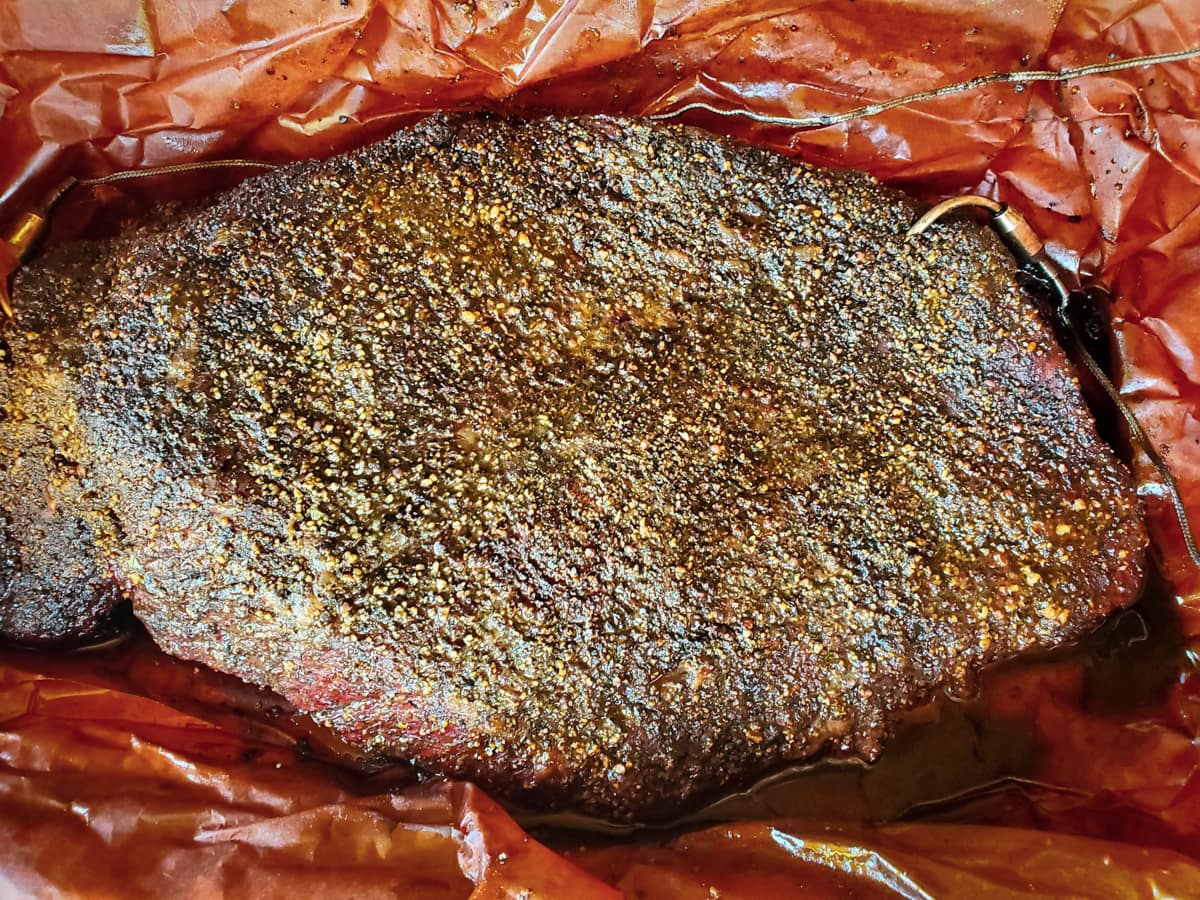
The foil boat method: The foil boat method of wrapping brisket is another adaptation that was popularized on the competition circuit. In this method the brisket is placed in a foil pan or foil boat once the bark is set, either by leaving the top open or then wrapping in peach butcher's paper. This allows the drippings to be collected and keeps the bottom of the brisket from drying out, while still maintaining the bark on the brisket.

When do you wrap a brisket?
This question seems to pull the most incorrect answers on online forums and BBQ groups. You will frequently see that you always wrap at 165 degrees or 160 degrees, etc. Or wrap as soon as you hit the stall. In reality, you only ever want to wrap your brisket when your bark is set and the brisket has the color you like. If your brisket is at 165 and you have a soft pale bark, you will never achieve the bark you want by wrapping at this point, and in reality your bark will get even softer.
You know your bark is set when you can run your finger over the brisket and the bark/rub does not come off. Wrapping your brisket before this is going to result in a mushy, soft bark.
How long should I/can I rest a brisket?
Resting or holding your brisket is essential to letting liquids redistribute in the brisket, and help the brisket become more tender. If you have wrapped the brisket during the cook, we recommend unwrapping the brisket for about 10 minutes to let it vent before wrapping it back up and resting or holding.
The brisket can be held in a Cambro or in a cooler that has been prewarmed. After placing the brisket in the cooler, wrap with towels to help retain more heat. The brisket can be held as long as the temperature of the brisket remains above 140 degrees. As such, we often continue to monitor the temperature of the brisket.
Warm holding a brisket
Recently there has become a technique of holding a brisket in a warm oven at 160-170 degrees for up to 12 hours. At this temperature the meat still continues to cook slowly, and collagen continues to break down. As a result, it helps to tenderize the brisket for cooks that pulled the meat from the smoker before it was tender (e.g. blindly at 203). Other than the potential of softening the bark of the brisket, there is typically little harm in doing this. If you pull your Texas style brisket off the smoker at the appropriate tenderness, this is not typically necessary. We find a 4-8 hour rest/hold to be ideal.
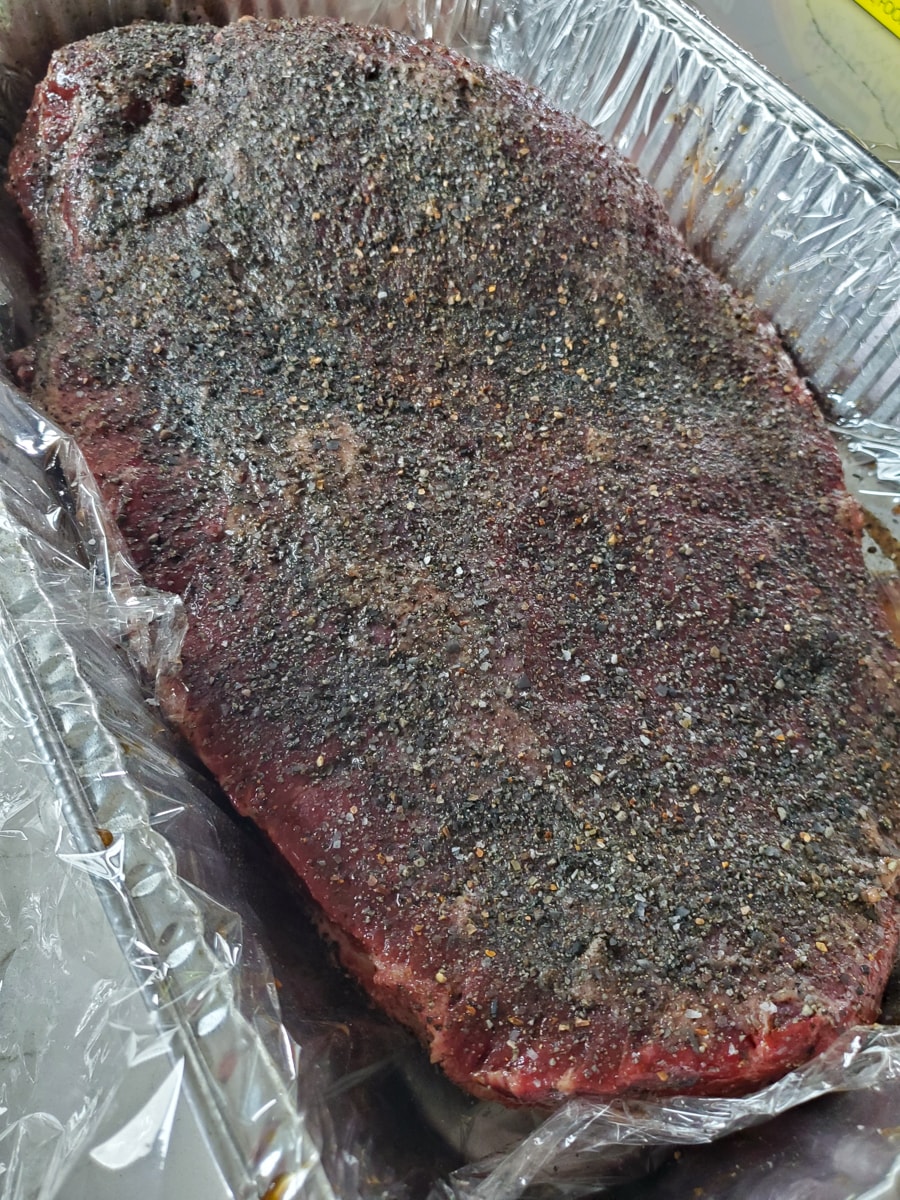
How to slice and serve a Texas Style Smoked Brisket
To slice the Texas Style Smoked Brisket for serving, place the brisket on a large cutting board. Cut the brisket in half to remove most of the flat from the brisket. Be certain you are slicing against the grain.
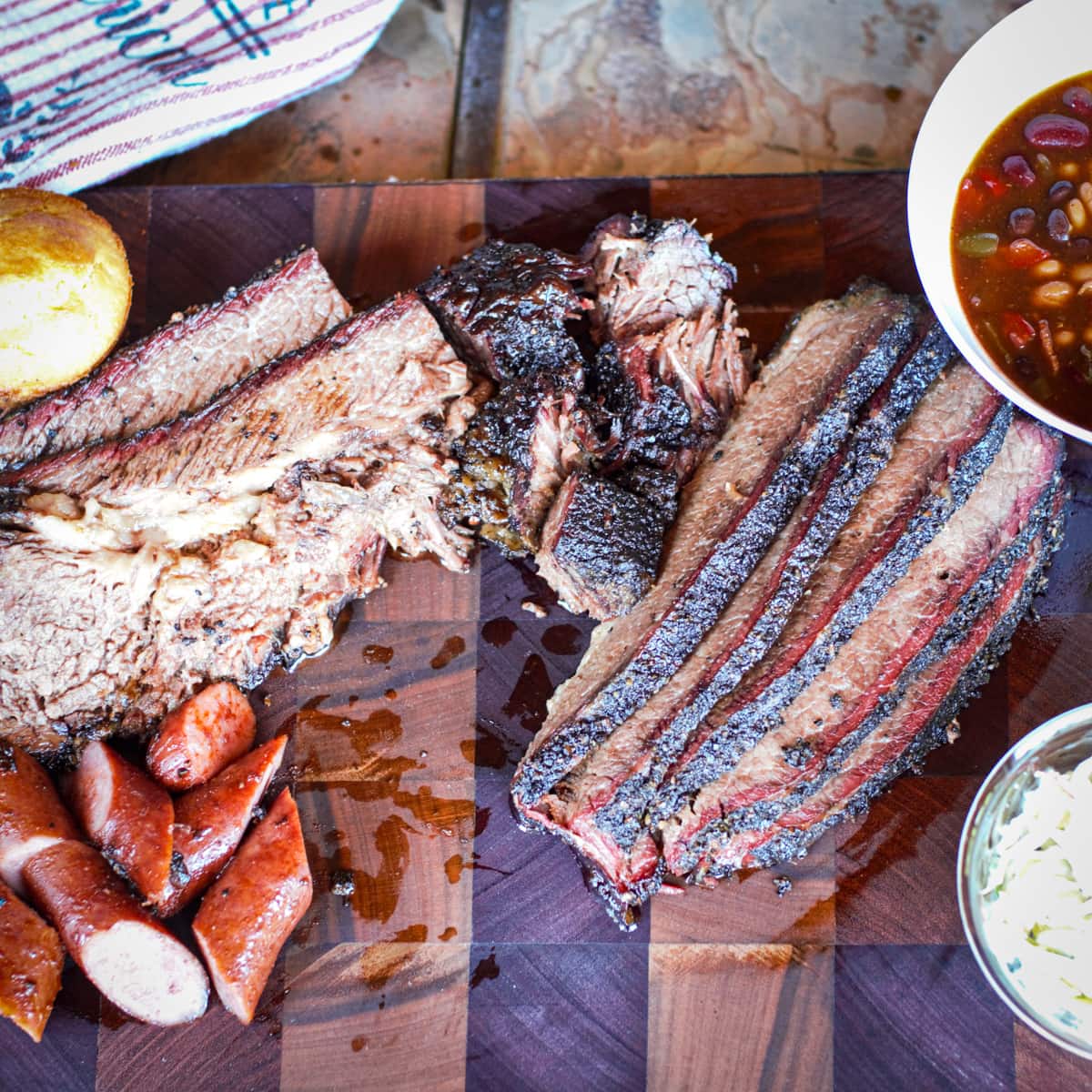
We find it helpful to check the brisket tenderness at this point. Cut a slice of brisket into about ¼ inch slice. This is roughly the width of a pencil. You want the brisket slice to freely bend over your finger or the knife. This is known as the bend test for a brisket. If it is too stiff, the brisket may not be very tender. If this is the case, you may want to slice the brisket into thinner slices. Alternatively, you can wrap the brisket back up and heat it a little longer or give it a longer "warm hold" at about 160 degrees, until it becomes more tender.
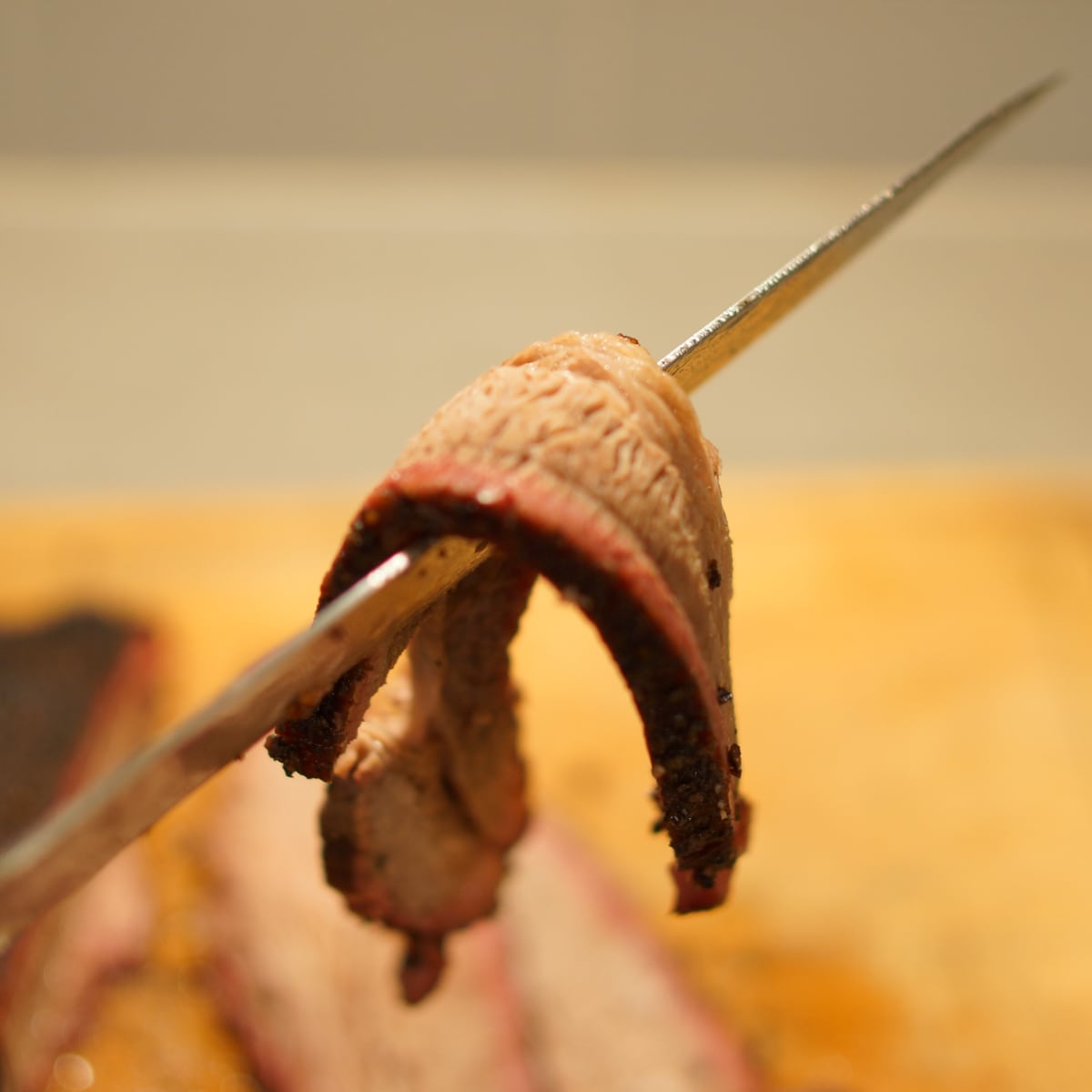
Next, take the slice of the brisket and pull it between your fingers. This is known as the pull test. The brisket slice should pull apart easily without too much resistance. If it is hard to pull, the brisket is likely undercooked. If the brisket falls apart when you pick it up, it is likely a little overcooked. For an overcooked brisket, slice into thicker slices.
If you are happy with the tenderness of your brisket, continue to slice the flat into ¼ slices. In Texas this is the "lean" brisket
Next, rotate the point side of the brisket 90 degrees. If desired, cut off the edge and cube into burnt ends. Continue to cut slices into the width of your thumb. In Texas this is referred to as the "moist" portion of brisket.
Now your Texas Style Smoked Brisket is ready to eat.
What to Serve with Texas Style Smoked Brisket
Texas style brisket goes great with other smoked meats like ribs or sausage. Spicy cornbread, homemade coleslaw, potato salad, and smoked Mac and Cheese are also great side options.
For more great BBQ recipes, be sure to try some of our favorites here:
- Eastern North Carolina Pulled Pork
- Spatchcock Chicken
- Beef Short Rib Burnt Ends
- Best Alabama White BBQ Sauce
Other frequently asked questions when cooking a brisket
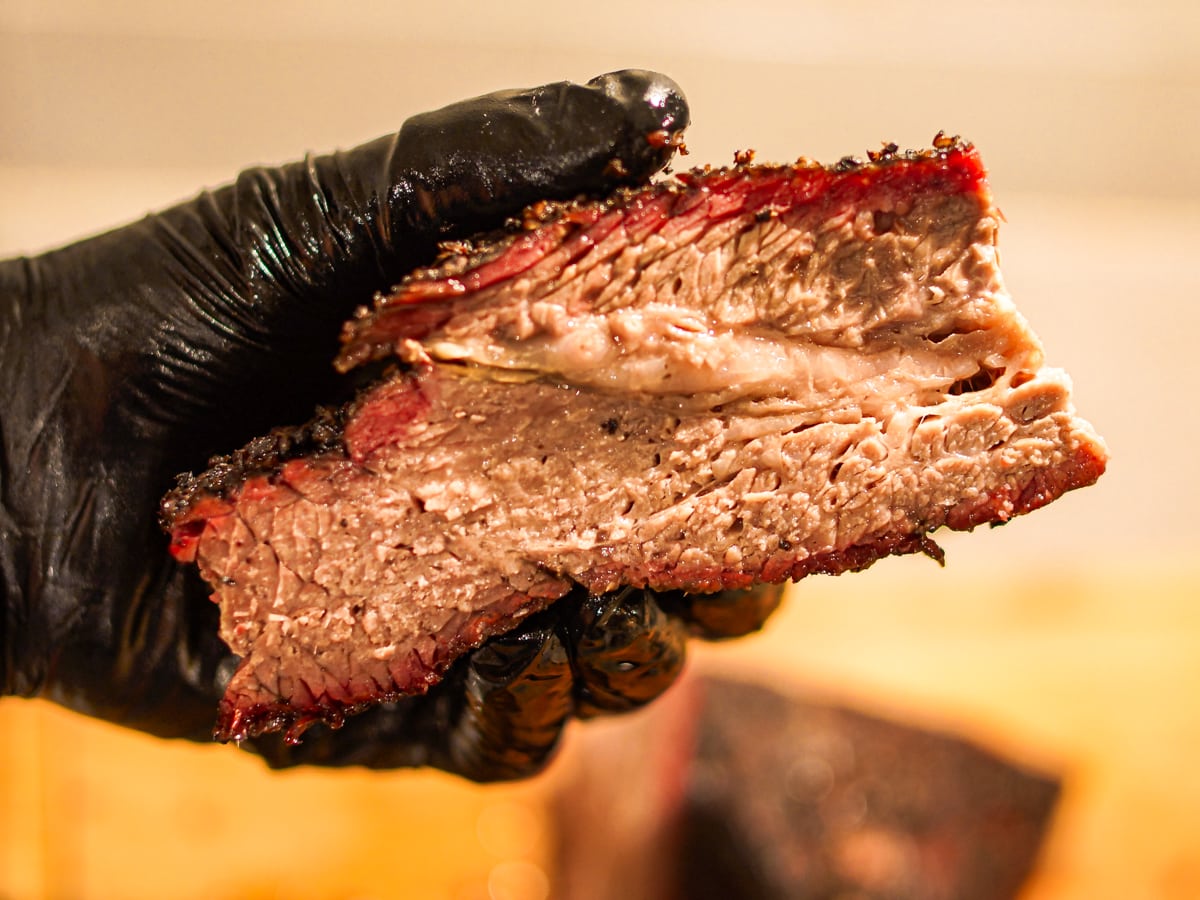
I just opened my brisket, and it smells funny
This is another common concern I see on occasion. You have picked your prefect brisket, perhaps you wet aged it, and now cook day is finally here. Excitement is in the air. You cut open your Cryovac and the excitement dissipates as you are greeted by an off smell. There are several things that can be going on here, and thankfully most of them do not mean that your 16 pound hunk of meat is ruined and you will be going to Famous Dave's for dinner. Typically these smells, especially smells like sulfur or "rotten eggs" are a result of the Cryovac process and off-putting by the meat in the Cryovac.
Once placed in cryovac, the brisket continues to break down in the packaging and those gasses have nowhere to go, so they concentrate in the packaging. It is fine, this break down is what helps to make your meat more tender with wet aging, it does not indicate that the meat has spoiled or gone bad.
If, however, you were unfortunate enough to have a brisket where the integrity of the packaging was compromised at some point, you may be greeted with an entirely different smell. In the case of meat that has truly spoiled or gone rancid, I promise you will know it. This smell will clear the room, your spouse will be cursing at you and you may be considering staying in a hotel. There is no confusing the smell or rotting meat. If this occurs get the meat out of your house ASAP and cut your losses. Thankfully, in the 10 years of cooking meat and BBQ I have only come across this once and that was with a package of ribs.
What type of wood should I use to smoke Texas Style Smoked Brisket?
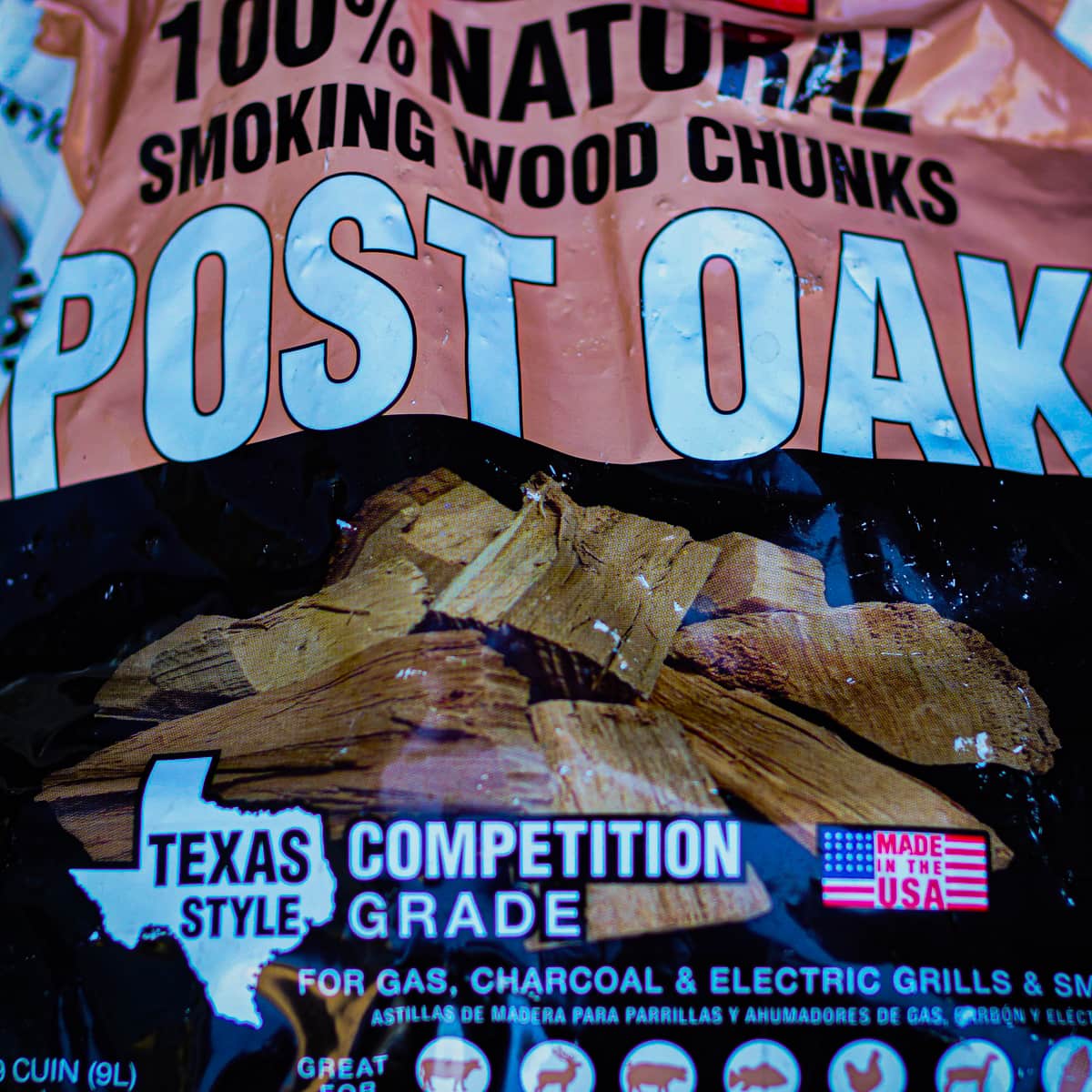
Most commonly Texas style smoked brisket is cooked over post oak, and it is definitely one of our favorites. Hickory or pecan are also great woods for brisket. If you love mesquite that is an option too, but it has a strong flavor that some people do not like, so if you love mesquite go for it. If you are not sure, a 16 pound brisket may not be the best choice to experiment with.
How do I get more of a smoke ring on a BBQ brisket?
As mentioned above a smoke ring is a chemical reaction between gasses and myoglobin in the meat. It has nothing to do with taste, but it looks cool and people still try to achieve it. Smokers that produce a lot of carbon dioxide and nitric oxide are going to typically give you the largest smoke ring. This includes pellet smokers and offset smokers burning wood or charcoal. Ironically, more carbon dioxide and nitric oxide are produced with hot fires than slow burning fires. Electric smokers, produce very little NO and CO so a smoke ring may be hard to achieve.
The smoke ring formation also smokes at about 170 degrees, so if you want a smoke ring, put the meat on colder. Keeping the meat surface cool and moist by spraying at the beginning on the cook can also help.
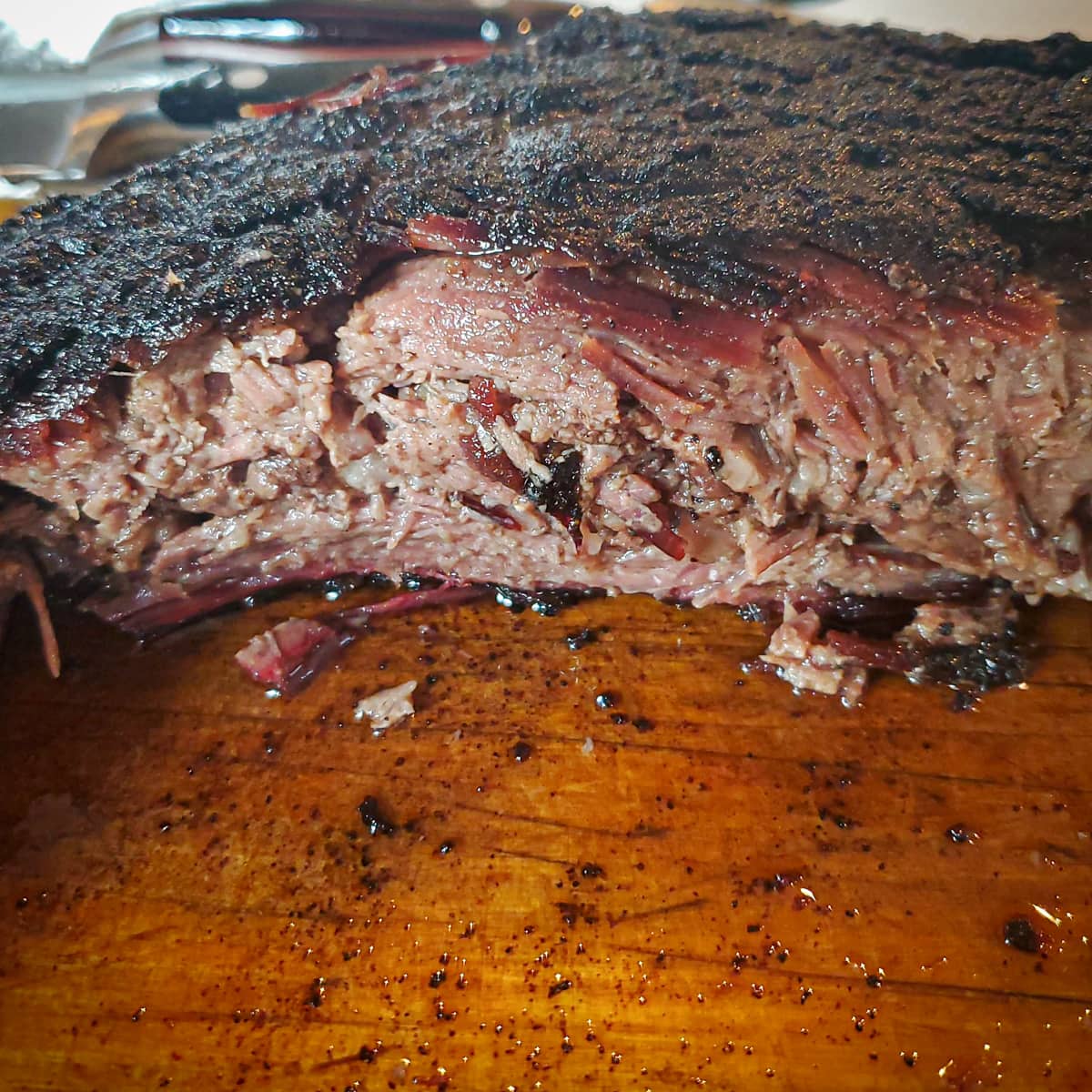
Have leftover brisket. Be sure to try some of the best recipes to make with leftover brisket:
- BBQ Poutine With Smoked Brisket
- Taiwanese Beef Noodle Soup with Smoked Beef
- Brisket Quesabirria Tacos
Addressing Common BBQ Myths
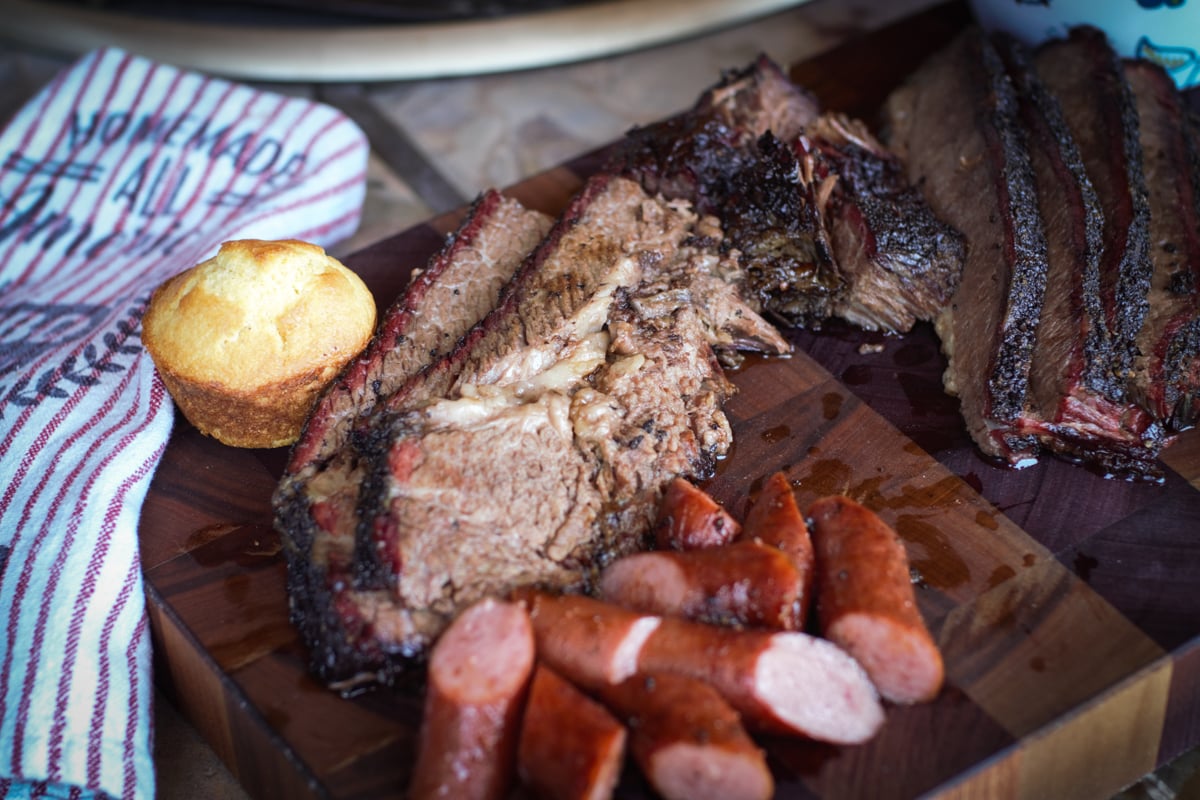
Over the years a number of myths have evolved around BBQ which can lead to some well-intended but bad advice. Here we cover a few of the most common as they may pertain to brisket.
Myth 1: A good smoke ring is a great indicator of a well cooked brisket
A proper smoke ring has become a badge of honor among some in the BBQ community. In reality, however, a smoke ring has nothing to do with smoke flavor and is just a chemical reaction between myoglobin and gasses like nitric oxide and carbon dioxide. For more a more detailed explanation on the science behind the smoke ring, Amazing Ribs has a great summary of how a smoke ring is formed.

Myth 2: Smoke stops sticking to the meat after the meat reaches a certain temperature.
There is a popular myth that meat stops taking on smoke flavor once the meat hits a certain temperature. Some say smoke stops at 130, others say 160. The fact is that the meat will continue to take on smoke flavor as long as it is in the smoker. The amount of smoke flavor that is picked up on the surface of the meat will decrease as the surface dries out, and the bark formation slows adherence, but this has nothing to do with the temperature of the meat.
Some of this myth is due to confusing smoke ring with smoke flavor. The chemical reaction resulting in a smoke ring does stop as the myoglobin in the meat is denatured around 170 degrees. This has no effect on smoke flavor, however.
There has been plenty of research debunking this myth and we have any done an experiment by cooking a pork butt in a sous vide to 165 degrees and then finishing in the smoker. The result was still a smoky, flavorful brisket.
Myth 3: Soaking your wood before smoking is beneficial.
Smoking your wood actually has very little effect as the wood only absorbs the water at the surface. This limited water is then quickly cooked of as steam once the wood hits the fire. In addition, the damp wood can lead to a period of smoldering and dirty smoke, which is best avoided to avoid bitter/creosote flavors in your meat.

If you have any other questions you want answered about smoking a brisket, please leave a comment, and we would love to address it.
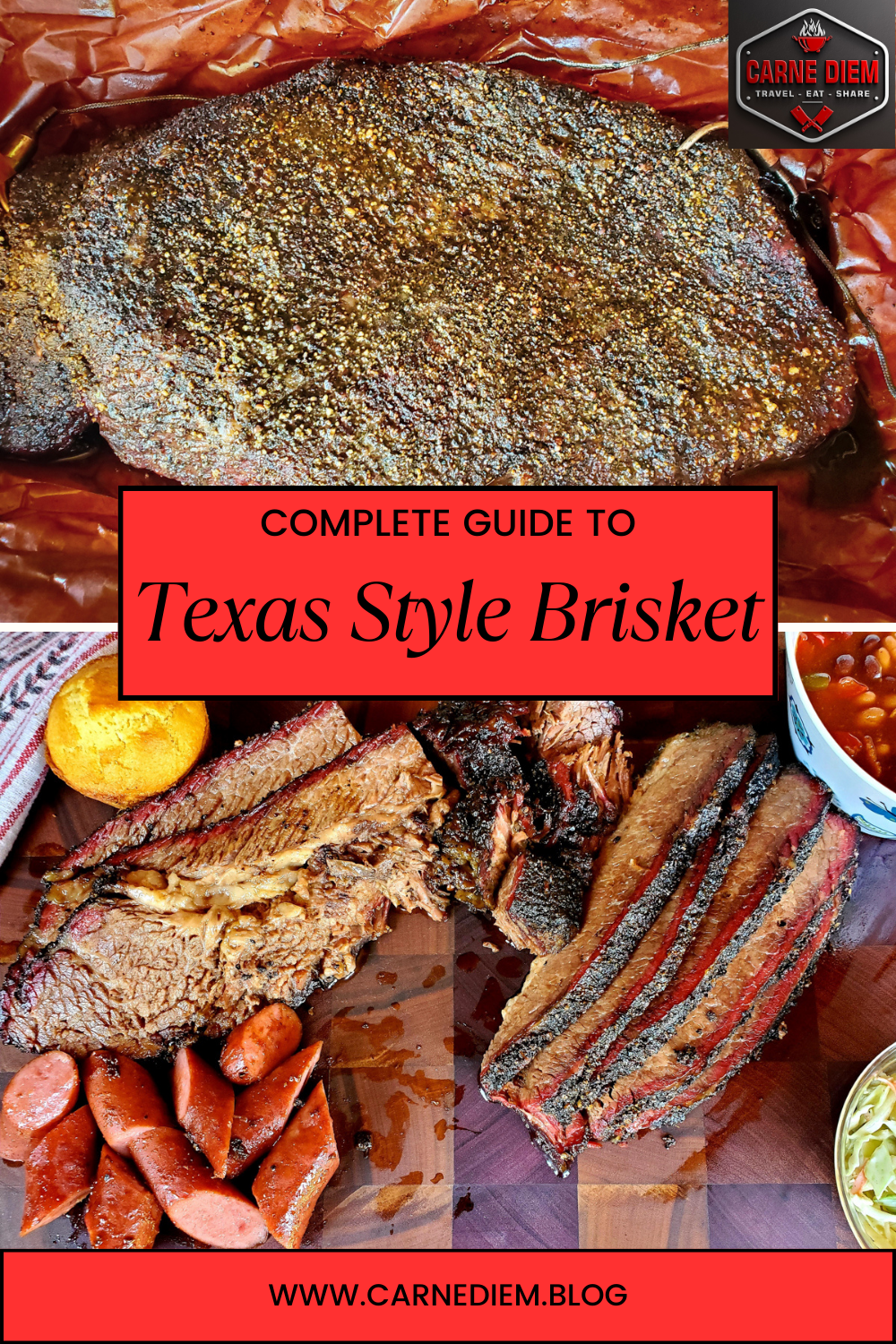
Thank you for taking the time to visit our blog. If you tried and enjoyed our recipe, please share with others and please leave us a comment and review. We also love to see your pics so don’t forget to tag us @Carne_Diem_Culinary or #CarneDiemBlog. To be notified of future recipes please follow us on Facebook, Instagram, or Pinterest, or sign up for our e-mail notifications. Until next time, Carne Diem!


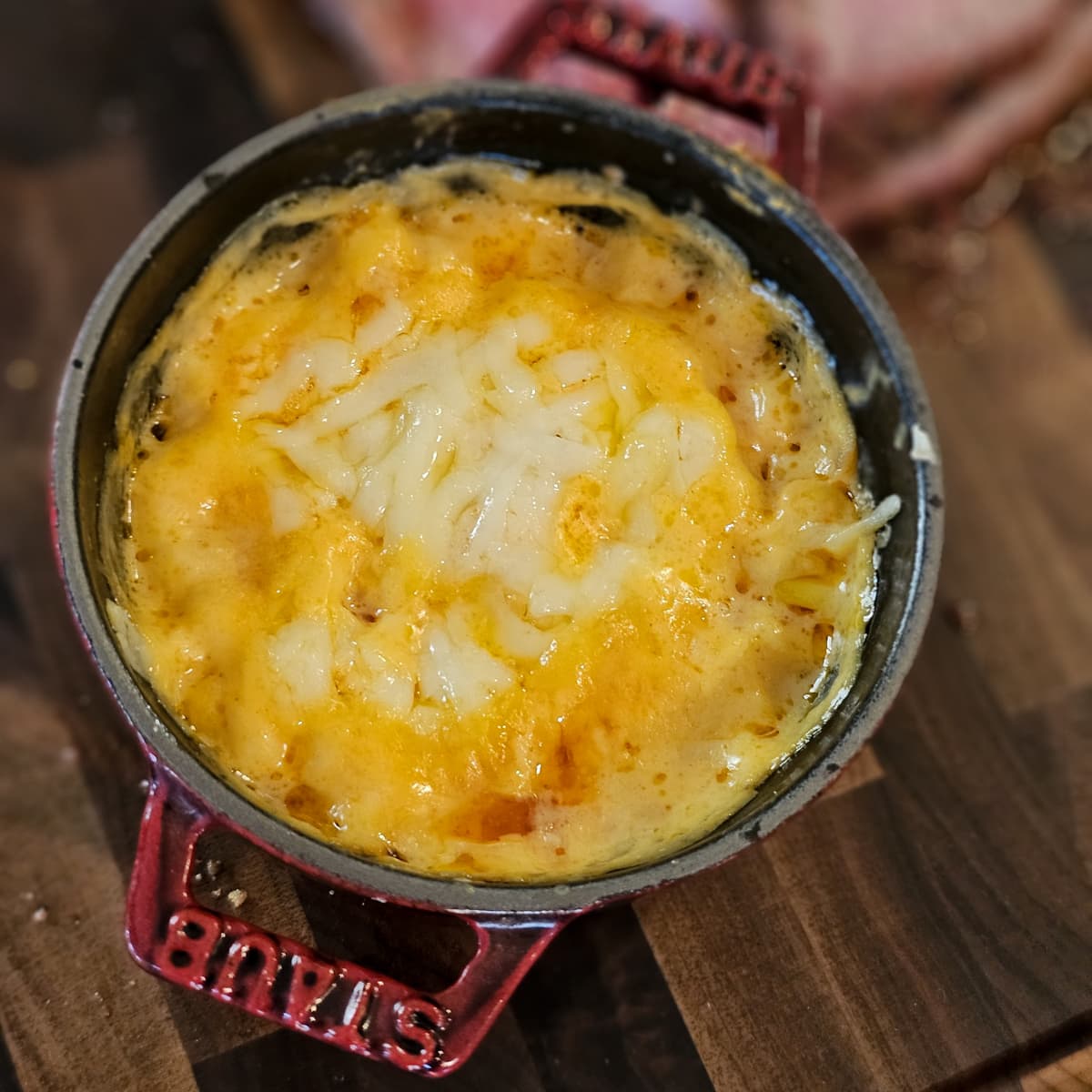
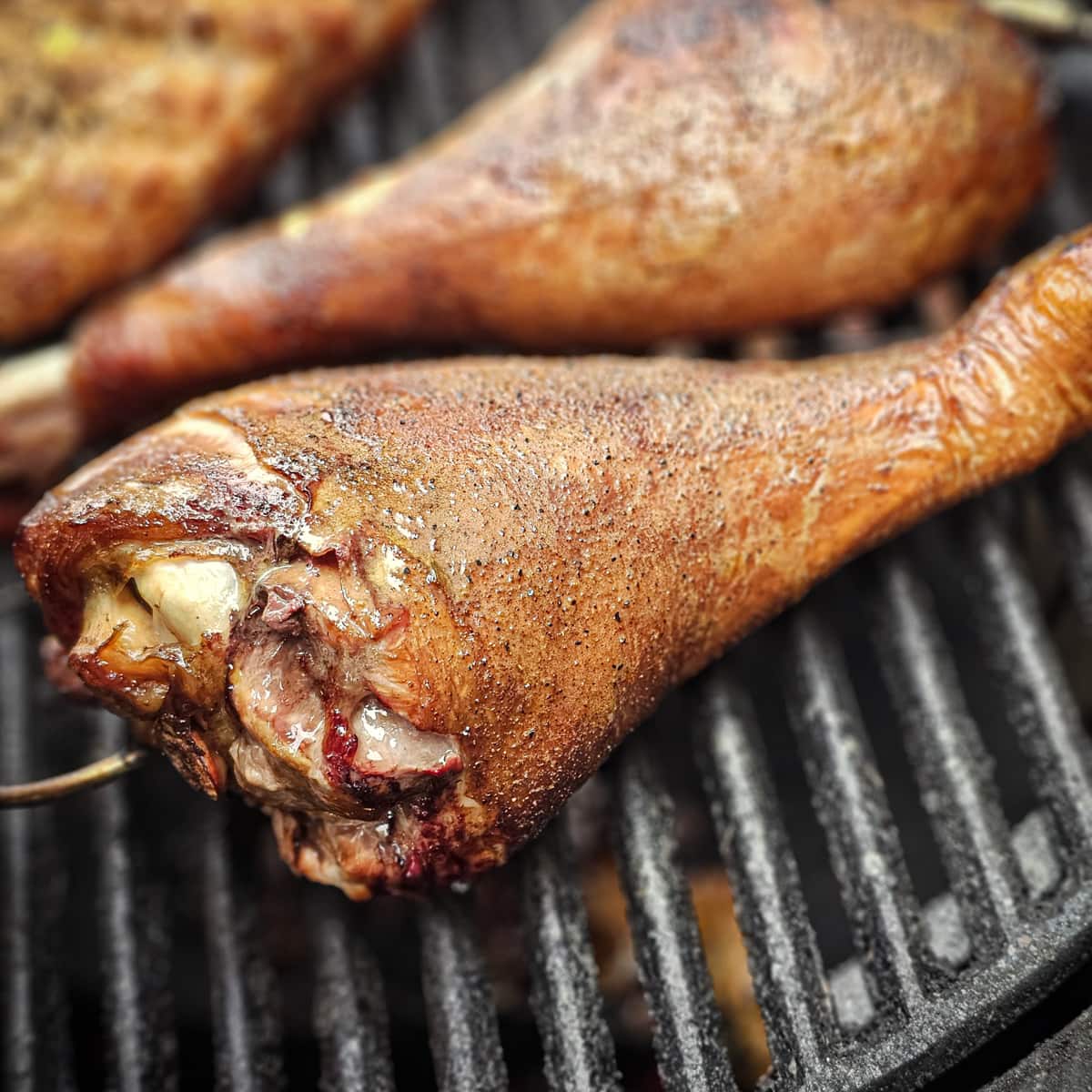
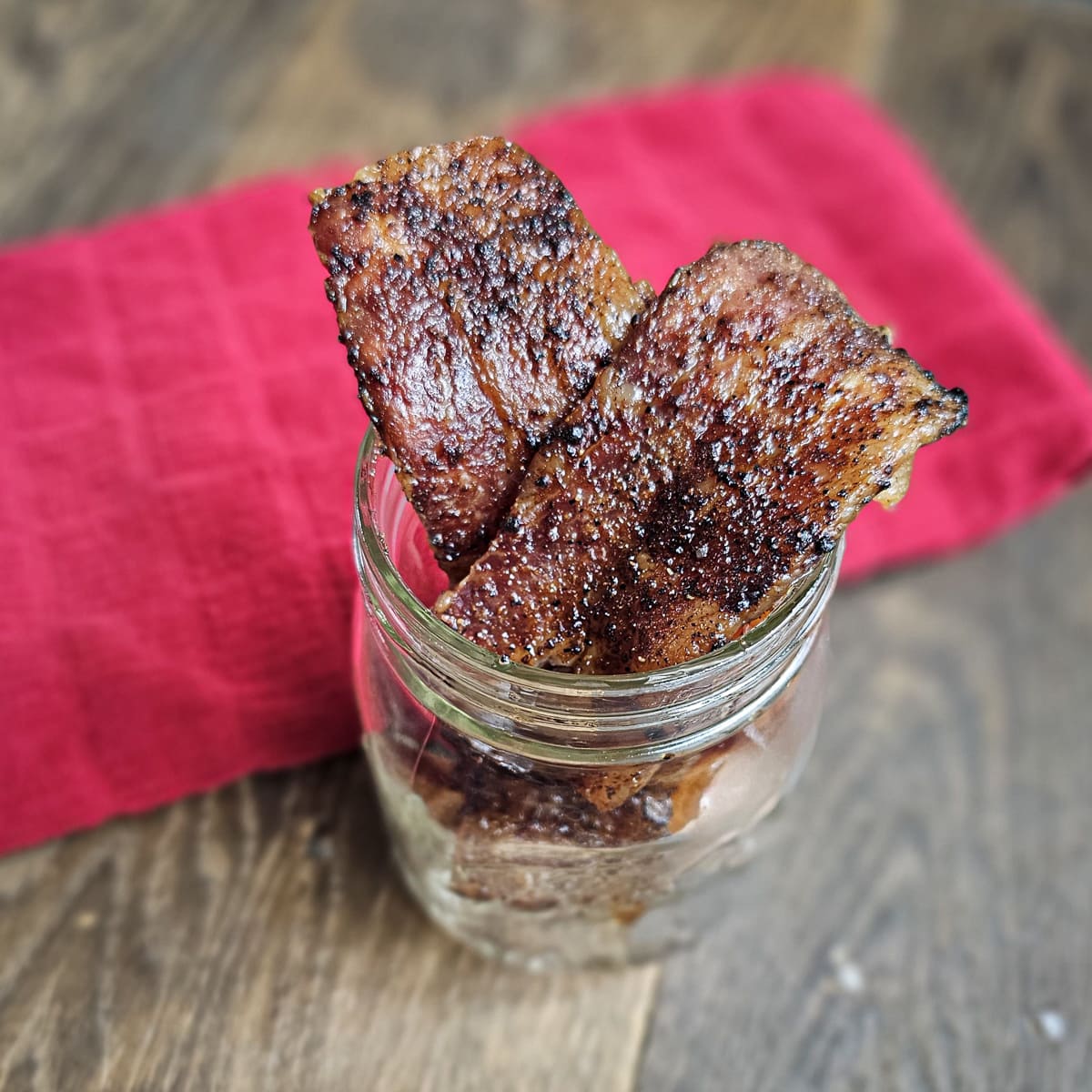
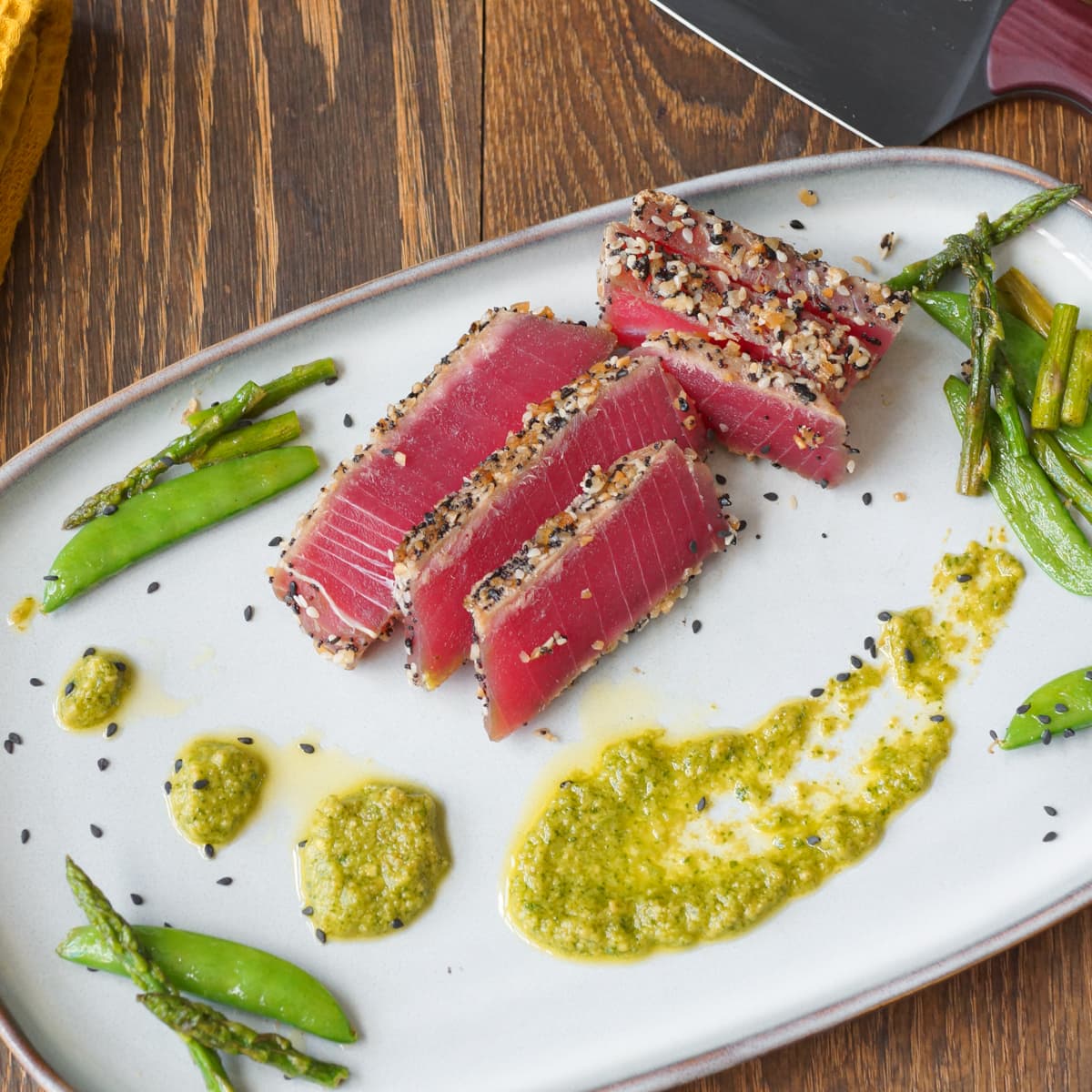

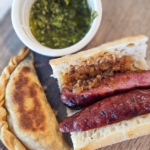
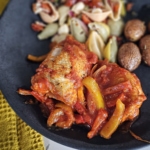
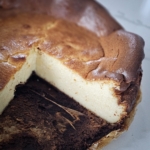
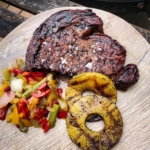
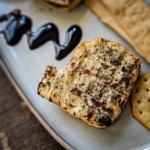
Bill H.
Great guide and a lot of really good information. 100% agree about cooking to tenderness and not just temp.